Living in Phoenix means your roof takes a beating from the intense sun, sudden storms, and seasonal monsoons. Over time, this wear adds up—making repairs not just likely but necessary. Understanding what impacts roof repair costs and how to avoid costly mistakes can save you thousands.
In this guide, we’ll break down flashing essentials, common issues, and practical maintenance tips every Phoenix homeowner should know to keep their roof in top shape. So, what exactly is flashing on roof , and why is it so essential to the health of your home?
Roof flashing is a thin material—usually made of metal like aluminum, copper, or galvanized steel—that’s installed in areas of your roof that are especially prone to leaks. It’s typically found around chimneys, skylights, roof valleys, vents, and where the roof meets vertical walls. Its main job? To direct water away from seams and openings so it doesn’t sneak into your home. “Parts of a Roof Diagram” is often used to help homeowners understand where flashing fits into the broader roofing system.
Flashing acts as a barrier that keeps rain and melting snow from getting underneath shingles or other roofing materials. Without it, even the smallest gap could become a major entry point for moisture. Over time, that leads to rot, mold, and expensive water damage.
Flashing doesn’t get much attention, but it’s one of the most important parts of your roofing system. The role of roof flashing in leak prevention becomes especially clear when dealing with tricky areas like chimneys or skylights. While shingles or tiles shed most of the water, flashing protects the places those materials can’t. It handles the tricky areas—like corners, curves, and junctions—that are otherwise vulnerable to water intrusion.
Here’s why flashing matters so much:
Whether you're building a new home, replacing an old roof, or doing routine maintenance, never overlook your flashing. If it's loose, rusted, or missing, it could leave your home exposed. A quick inspection or repair now can save you thousands later.
Bottom line? Flashing may be out of sight, but it should never be out of mind.
Roof flashing comes in several types, each designed to protect specific areas of your roof where leaks are more likely to occur. Understanding the different kinds helps you spot problems early and keep your roof in good shape.
1. Continuous (Apron) Flashing
This type runs along a roof edge or dormer and directs water down and away. It includes expansion joints to allow the metal to flex as the roof naturally shifts with temperature changes.
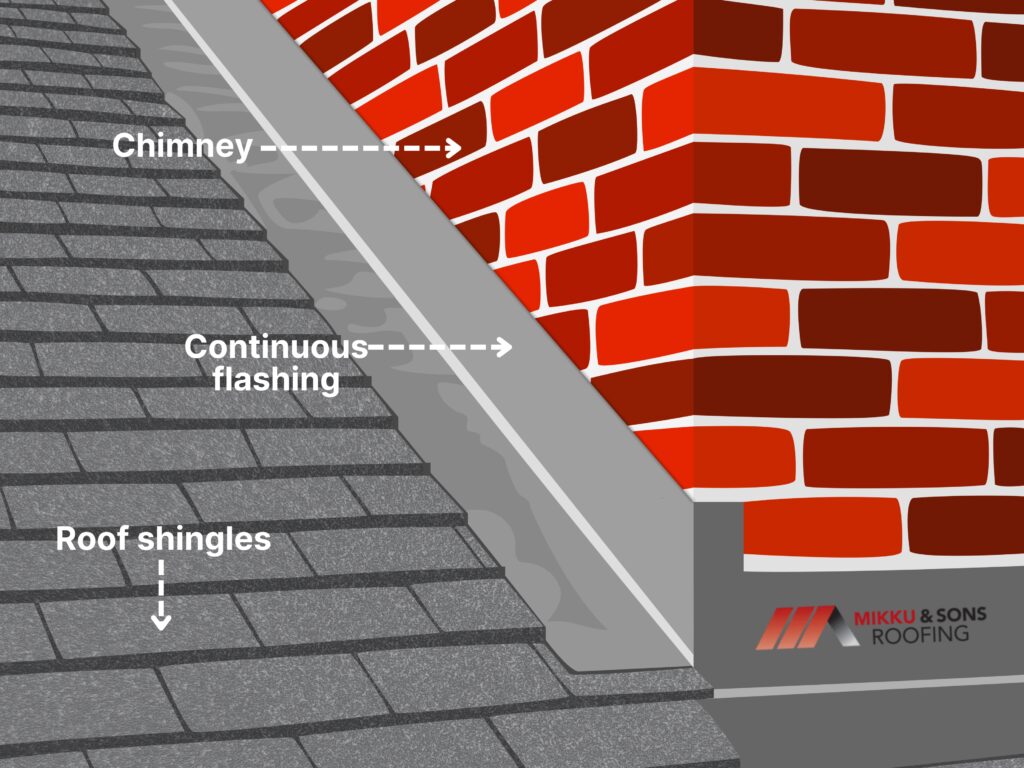
2. Step Flashing
Step flashing is used where the roof meets a vertical surface like a wall or chimney. Small L-shaped pieces of metal are layered between each row of shingles, guiding water safely down the roof instead of letting it sneak into gaps.
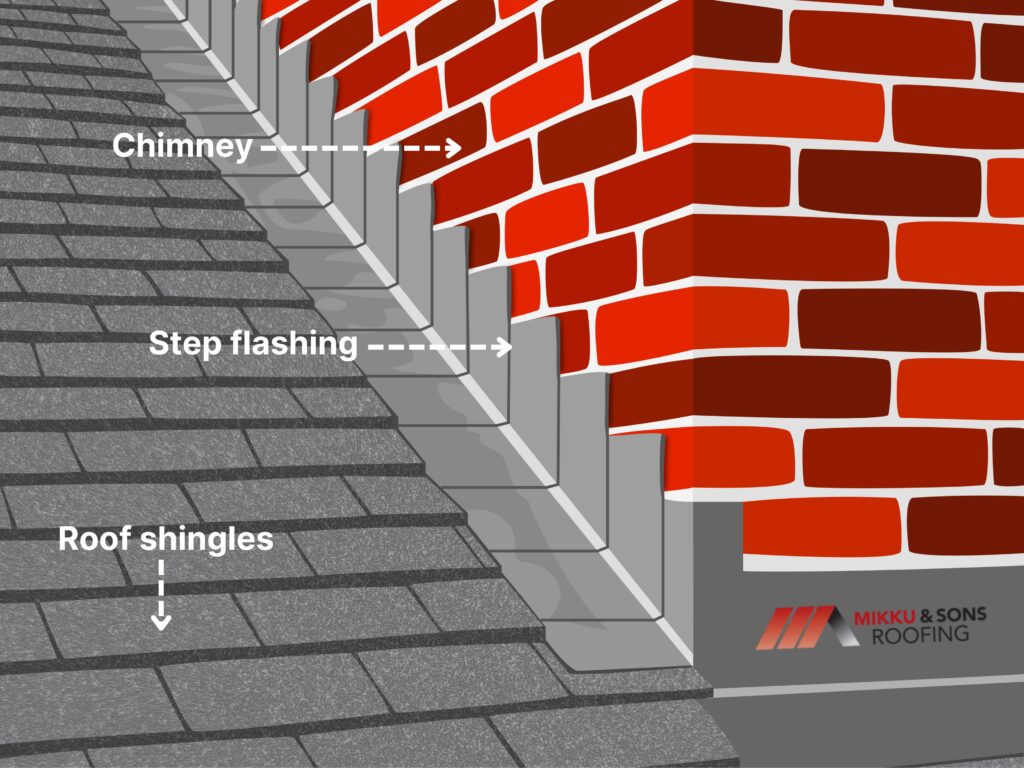
3. Drip Edge Flashing
Installed at the edges of the roof, drip edge flashing helps water flow into the gutters instead of seeping underneath the roof deck. It also prevents erosion and blocks pests from getting under the roofing material.

4. Valley Flashing
Valley flashing is placed where two roof slopes meet to form a valley. These spots collect a lot of water during storms, so the flashing ensures it’s funneled safely off the roof without pooling or penetrating shingles.
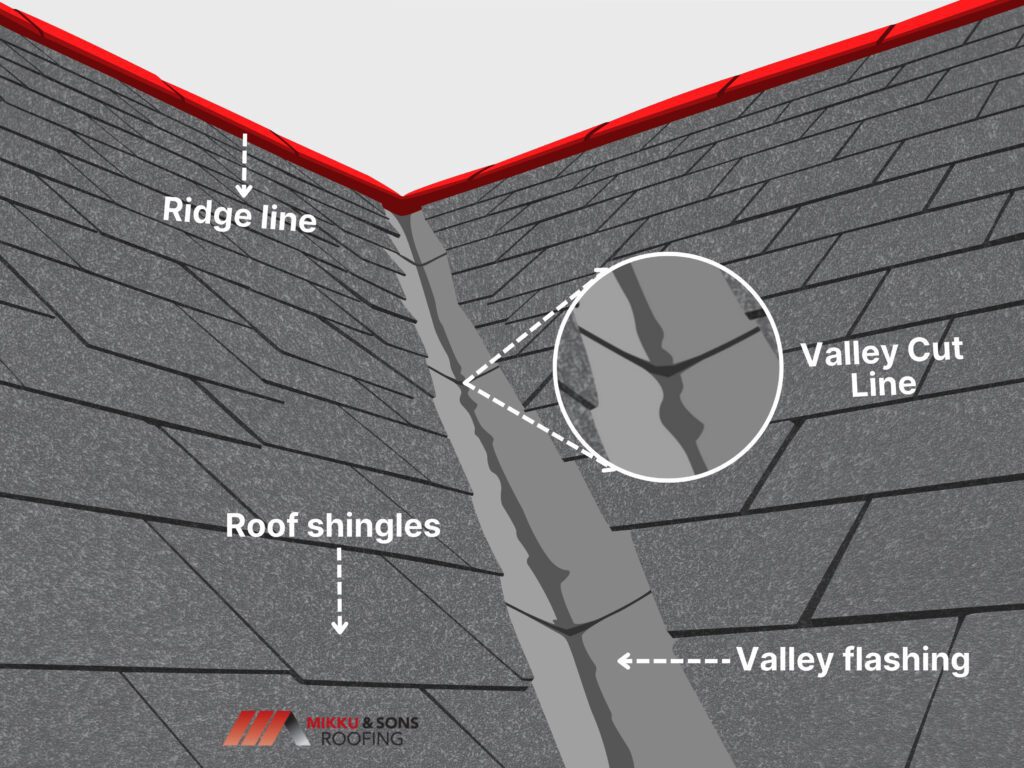
5. Vent Pipe Flashing
Vent pipes that come through the roof—like plumbing or exhaust vents—need special flashing to seal around them. This flashing usually includes a rubber or metal collar that hugs the pipe tightly.
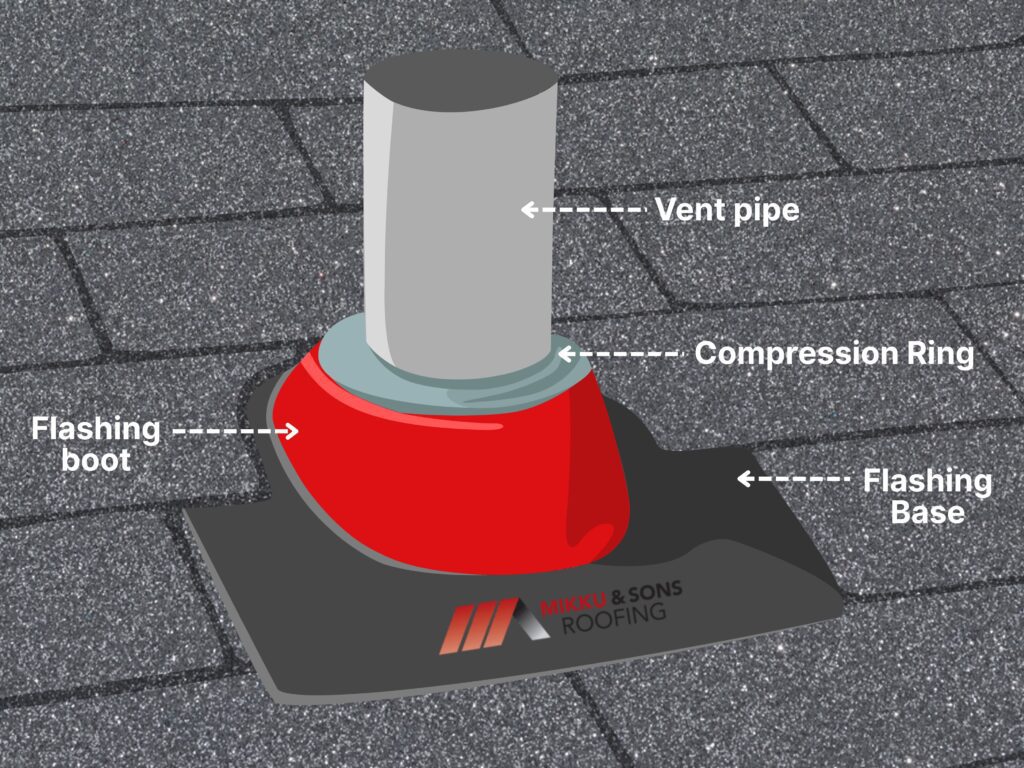
6. Skylight Flashing
Skylight flashing is custom-fitted around skylights and includes multiple components that protect the seams and corners, where leaks are most likely to form.
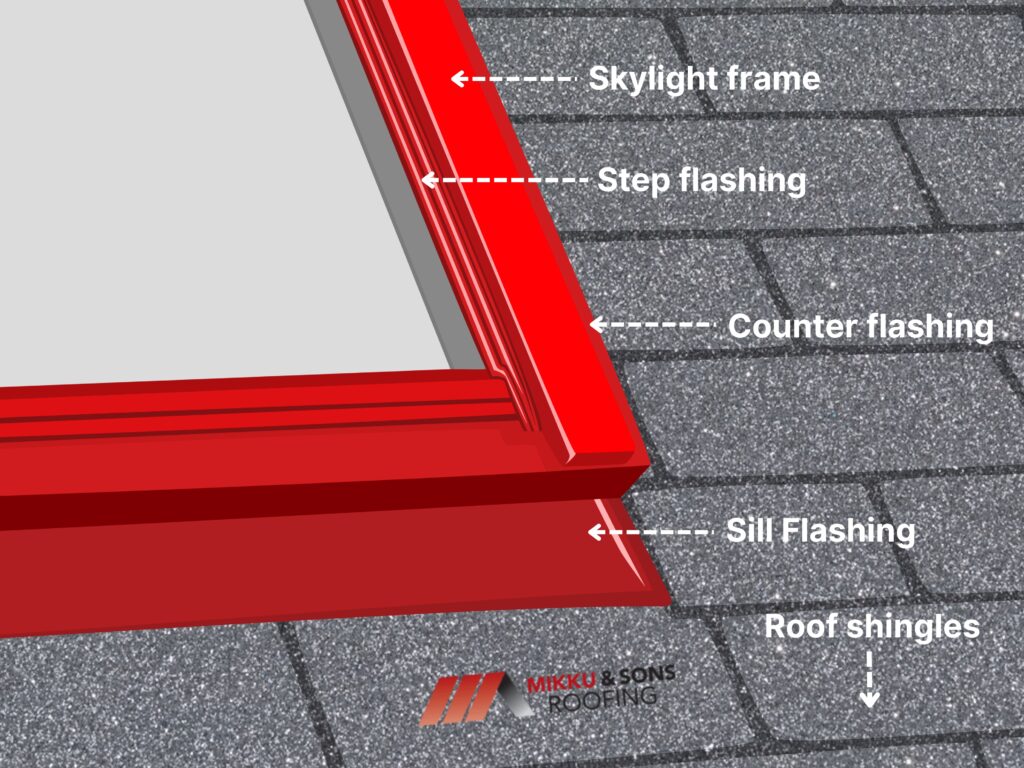
Flashing can wear out, shift, or become damaged over time—especially in areas with extreme weather. Knowing what to look for can help you catch problems before they lead to leaks or structural damage.
If you're wondering how to fix a leaking tile roof, checking the flashing should be one of your first steps.
Even the best roofing materials won’t perform well if the flashing is installed incorrectly. Flashing is your roof’s first line of defense against leaks at seams and junctions, but when it's poorly installed, it can do more harm than good. Here are some common mistakes to avoid:
1. Using the Wrong Type of Flashing
Not all flashing is the same. For example, step flashing should be used along vertical walls, while valley flashing should be used for roof valleys. Using the wrong type can leave gaps that water easily slips through.
2. Overlapping Issues
Flashing should be layered so water flows down and away from the roof—not back into it. If the metal pieces are installed without the proper overlap or in the wrong direction, water can get trapped and seep underneath the roofing materials.
3. Skipping Sealants
Sealants like roofing cement or caulk are often used to reinforce flashing around tricky areas. Failing to seal gaps, edges, or fasteners can allow water to sneak in and start causing damage over time.
4. Nail Placement Mistakes
Fastening flashing in the wrong spot—such as through the middle instead of the top edge—can allow water to penetrate through the nail holes. Nails should be placed strategically so the upper roofing materials protect them.
5. Poor Integration with Shingles
Flashing should be installed in conjunction with shingles, not just on top or underneath them. Improper layering allows water to get under the shingles and bypass the flashing completely.
6. Reusing Old Flashing During Roof Replacement
The cost of changing chimney flashing can vary, but it's a worthwhile investment if the existing one is rusted, loose, or missing entirely. Some contractors try to save time or money by reusing old flashing. This can lead to early failure, especially if the existing flashing is corroded, bent, or wasn’t installed correctly the first time.
Keeping your flashing in good shape doesn’t require a lot of work, but it does require consistency. Here are some tips to help you maintain your roof flashing and prevent leaks:
1. Schedule Regular Roof Inspections
At least once a year—and after any major storm—have your roof inspected by a professional. They’ll look for loose, damaged, or corroded flashing before problems get worse.
2. Check for Rust or Corrosion
Flashing is usually made from metal, which can rust over time. If you see signs of rust, it may be time to replace the flashing or at least clean and treat it with a rust-resistant coating.
3. Reseal as Needed
Sealant or caulk around flashing can dry out and crack over time. Resealing those areas ensures water stays out. This is especially important around chimneys, skylights, and vents.
4. Clear Out Debris
Leaves, sticks, and other debris can collect around flashing, especially in valleys or at roof edges. This can trap moisture and lead to deterioration. Keep those areas clean to avoid unnecessary wear.
5. Address Minor Damage Quickly
If you spot a loose piece of flashing or a small crack in the sealant, don’t wait. Small issues can quickly escalate into full-blown leaks and expensive repairs.
6. Avoid DIY Repairs Without Experience
It’s tempting to fix things yourself, but improper repairs often make problems worse. When in doubt, call a qualified roofer who knows how to handle flashing correctly.
Roof flashing may not be the most visible part of your roof, but it plays a critical role in preventing water damage and extending roof life. From identifying early signs of failure to avoiding installation mistakes, these insights help Phoenix homeowners stay ahead of costly repairs. Whether you’re budgeting for flashing replacement or maintaining what’s already there, proper care ensures long-term protection. When in doubt, consult a roofing professional—your home is worth the investment.
With your home in mind, you probably think about the kitchen, living room, or even your lawn, but what about your roof? It does its job every single day, protecting everything underneath it without much attention.
When something goes wrong like a missing shingle, roof tile or a slow leak the roof becomes the center of focus. You get left trying to figure out what part of your roof even needs fixing.
That’s why understanding the different parts of your roof comes in handy. You need a basic idea of what’s up there to save you time, money, and stress. Think of it like getting to know the anatomy of your home.
Your roof is built with layers, each playing a different role in protecting your home. These parts work together to manage moisture, support weight, and shield your house from wind, sun, and snow.
| Layer | Location | Purpose | Common Materials |
| Decking | Bottom-most layer | Structural support for all roof materials; holds weight of shingles, snow, etc. | Plywood, OSB (Oriented Strand Board) |
| Underlayment | Between decking & covering | Moisture barrier; protects against wind-driven rain | Felt paper, Synthetic sheets |
| Roof Covering | Topmost visible layer | Weatherproof shield; gives roof its appearance | Asphalt shingles, Metal, Clay tiles, Wood shakes |
When you know what’s stacked up there, it becomes easier to spot issues, ask the right questions, and stay in control during repairs or upgrades. Most of what keeps your roof working properly isn't even visible from the outside.

Before anything else goes on your roof, the decking comes first. This is what supports everything above it, including the weight of shingles, underlayment, and even snow in the winter.
Decking usually covers the entire structure, creating a flat and solid surface for the rest of the roofing materials. You may never see this part of your roof unless there's major work being done, but it is important.
Weak or rotted decking can make the whole system less stable and put your home at risk for leaks or sagging. That’s why roofers always check the condition of the decking during major repairs or replacements.
Right above the decking lies the underlayment. This layer adds a second line of defense against water, especially in case wind drives rain under your shingles.
It’s installed between the base and the top layer, but without it, water could slip through even the smallest gaps. There are a few different types of underlayment materials, including felt and synthetic options.
Each one has its own set of pros and cons, but all of them aim to prevent moisture from getting into the structure of your home.
This is the part you see when you look up at your house from the driveway. Shingles, tiles, or panels make up the outermost layer and take the full force of the weather.
They’re built to keep water out, reflect sunlight, and give your home a finished look. Your choice of roof covering often depends on your local climate, budget, and personal taste.
Asphalt shingles are one of the most common, but you might also come across metal panels, clay tiles, or wood shakes depending on where you live.
A roof is shaped by lines, edges, and meeting points that do more than add structure. These spots tend to be where water collects or changes direction, which makes the
m more vulnerable to leaks and wear.
| Feature | Location on Roof | Function | Common Problems |
| Eaves | Roof edge (overhang) | Directs rainwater away; allows attic ventilation | Clogs, rot, poor ventilation |
| Fascia | Visible board at eaves | Holds gutters; protects edge of decking | Warping, water damage, pest intrusion |
| Ridge | Peak where two slopes meet | Allows ventilation through ridge vents | Cap shingles loosening, leaks |
| Hip | Sloped edges between sections | Adds structure; protects meeting points of different roof slopes | Wind damage, misaligned shingles |
| Valley | Inward angle where slopes meet | Channels rainwater down to gutters | Debris buildup, leaks, rusted flashing |
It’s easy to think your roof cladding is doing all the work, but areas like roof edges and ridges carry just as much weight in keeping your home protected. They control how water moves, how air flows out, and how everything stays sealed at the seams.
The eaves are the bottom edges of your roof that hang past the side walls of your house. They help move rainwater away from the structure and give space for ventilation under the roof.
The part you actually see from the ground is usually the fascia board, which runs along the edge and holds up the gutters. The fascia also protects the edge of the decking from moisture, pests, and anything else that shouldn’t be getting inside your roof.
When this part starts to rot or pull away, water can slip in and do more damage than you’d expect. That’s why it’s a good idea to keep an eye on it and make sure it doesn’t look warped, soft, or cracked.
The ridge is the highest point of your roof, where two sides meet at the top. It runs along the peak and needs to stay sealed to keep out water while still allowing air to flow through.
Hips are similar, but they’re found on the sloping edges where different roof sections meet. Both ridges and hips can get hit hard by wind and weather.
That’s why special shingles, caps, or vents usually cover these areas to keep everything watertight. If those start to shift or wear out, leaks tend to start right along these lines, so it’s worth checking them after storms or heavy snow.
Valleys are the places where two slopes meet at an inward angle, forming a low line that rainwater naturally follows. Since so much water flows through here, valleys are one of the first places that start to show wear or leak when things go wrong.
Roofers usually reinforce these areas with metal flashing or extra layers of protection, but even then, debris like leaves and branches can build up and trap moisture. Cleaning them out and making sure nothing looks cracked or rusted can keep you ahead of most issues that start in these low points.
Your roof also helps your home breathe and stay dry in ways that aren’t always obvious. Two key systems help make that happen, ventilation and drainage.
| Component | Role | Common Types | Why It Matters |
| Vents | Allows airflow in attic; removes heat/moisture | Ridge vents, Soffit vents, Box vents | Prevents mold, prolongs roof life, reduces energy costs |
| Gutters | Collect water from edges and direct it safely away | K-style, Half-round | Prevents leaks, wood rot, and foundation damage |
| Downspouts | Carry water from gutters down to ground level | Round, Square, Flexible extension pipes | Keeps water from pooling near the home |
Without them, heat builds up in your attic, moisture lingers, and water ends up where it shouldn’t be.
Hot air rises, and your attic collects more of it than any other part of your house. Without proper ventilation, that trapped heat can cause your shingles to age faster and raise your energy bills.
It can also lead to condensation, which soaks into insulation and wood, slowly causing damage over time. Roof vents allow fresh air to come in while letting warm, moist air escape.
There are several types, including ridge vents, box vents, and soffit vents. The layout of your home and roof shape usually determines which ones you’ll have.
Once rain hits your roof, it needs a clean path to move off and away from your home. Gutters and downspouts catch water along the roof’s edge and carry it down and out, keeping it from pooling near your foundation or spilling onto your porch.
Clogged or sagging gutters can cause water to back up, leading to leaks, wood rot, and even cracked concrete around the base of your house. Regular cleaning, secure fasteners, and making sure water flows the right direction are small tasks that go a long way in keeping everything dry where it should be.
The shape and profile of your roof can affect not only the look of your home but also how well it stands up to weather and other elements. Each type of roof profile has its own advantages, depending on where you live, the style of your home, and your specific needs.

The gable roof is one of the most recognizable and commonly used styles. Its simple triangular shape makes it effective at shedding rain and snow, which is why you’ll find it in places with heavy weather.
The steep slope also provides extra attic space for storage or ventilation. Besides its practicality, a gable roof offers a clean, timeless look.
You can dress it up with decorative touches or keep it minimal, making it perfect for various home styles. The only thing to keep in mind is that gable roofs can be vulnerable to strong winds, so make sure the structure is properly reinforced in storm-prone areas.
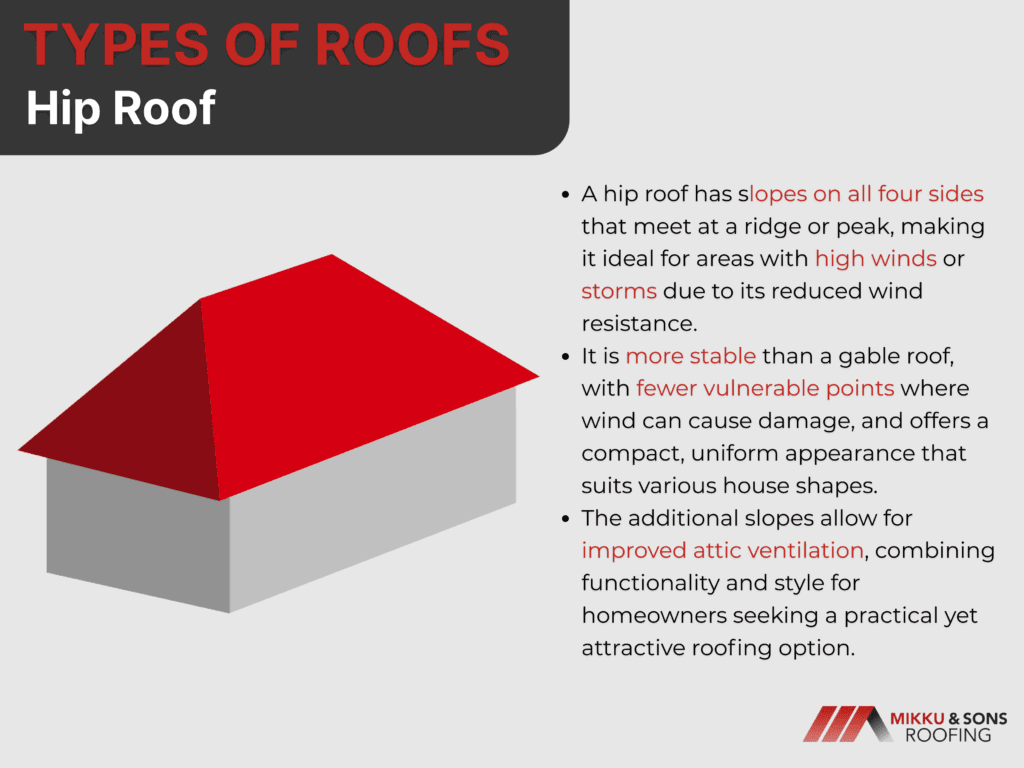
A hip roof has slopes on all four sides, meeting at a ridge or a peak. This style is especially beneficial in areas that experience high winds or storms because the angled sides reduce wind resistance.
Hip roofs are more stable than gable roofs, with fewer points where wind can catch and cause damage.The design offers a more compact, uniform look, which can work well with a variety of house shapes.
The added slopes also provide extra space for attic ventilation, making it an excellent choice for homeowners who want to keep their roof functional and stylish.

Flat roofs, as the name suggests, have a very slight pitch that’s almost level, making them ideal for modern homes or commercial buildings. They are typically seen in urban areas and are valued for their simplicity and functionality.
You can also use a flat roof for outdoor spaces like rooftop gardens, patios, or even solar panels. While flat roofs might seem low-maintenance, they do require attention to ensure proper drainage.
Without the right slope, water can pool on the surface, leading to leaks or structural damage over time.
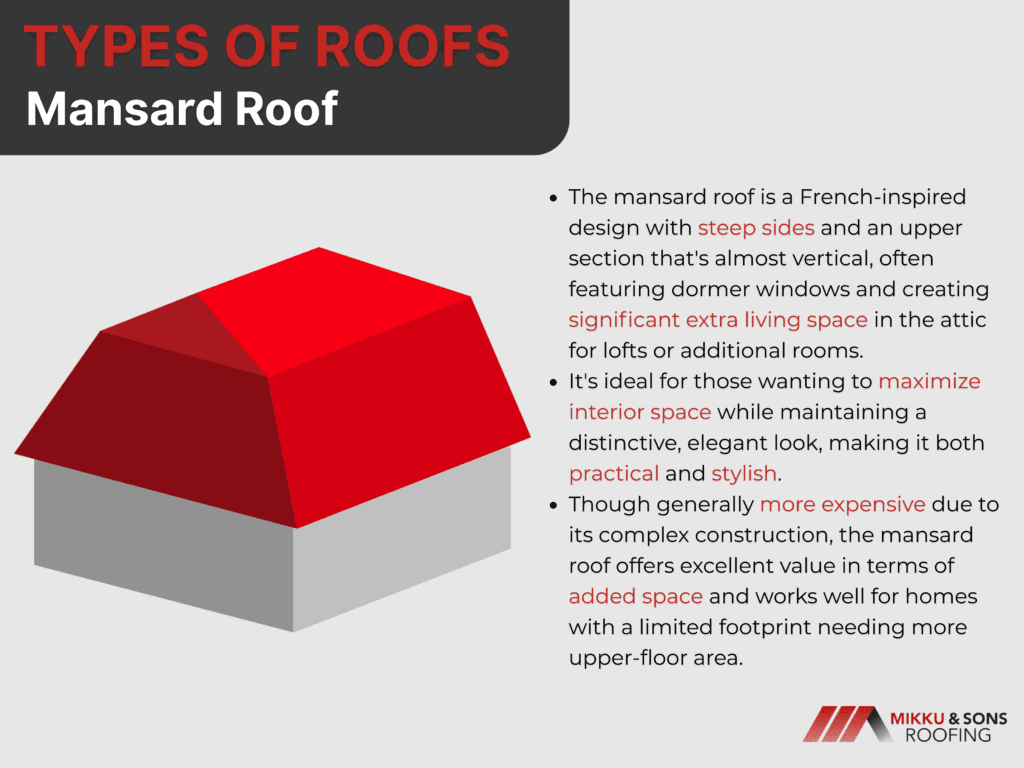
The mansard roof is a French-inspired design that features steep sides, with the upper section being almost vertical. The style often includes dormer windows and creates a lot of extra living space in the attic, perfect for a loft or additional rooms.
It’s a great choice if you want a roof profile that maximizes space while offering a distinctive look. Mansard roofs can be more expensive to install than simpler designs due to their complexity, but the trade-off is added space and a unique aesthetic.
They also work well for homes that need more upper-floor space but have limited footprint size.
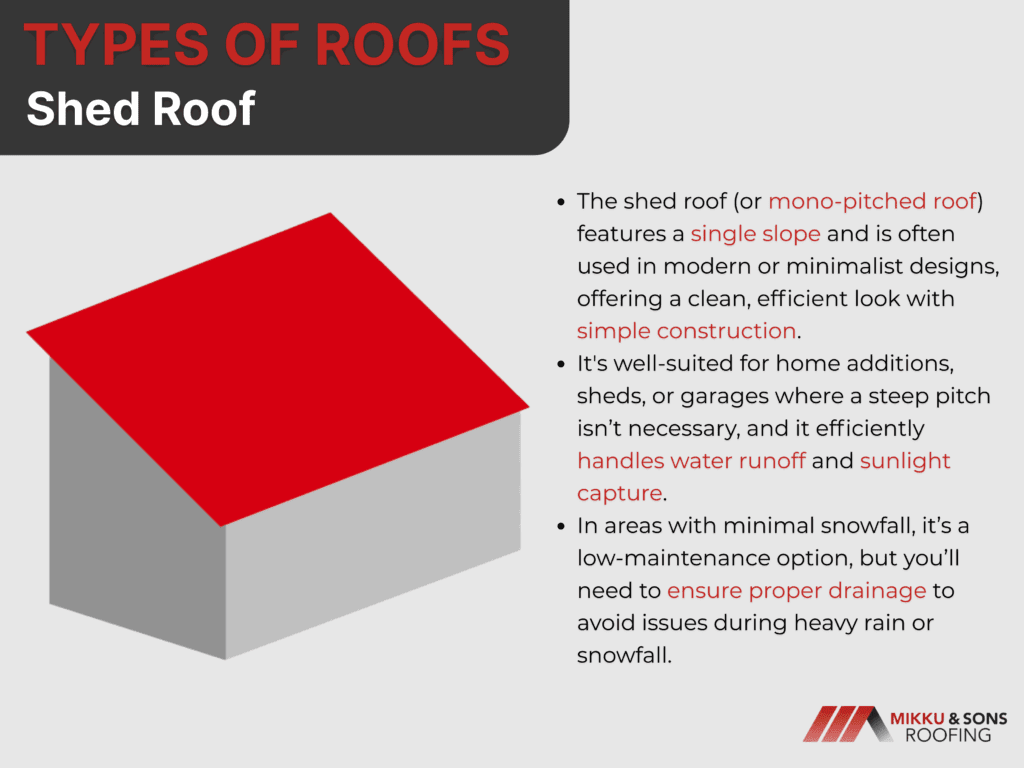
The shed roof, or mono-pitched roof, has one single slope and is commonly seen in modern or minimalist designs. It’s a straightforward, no-frills roof profile that’s perfect for those who want clean lines and efficient design.
Shed roofs are ideal for home additions, sheds, or garages, where a steep pitch isn’t needed. Though simple, shed roofs can be quite effective in terms of water runoff and sunlight capture.
In areas with minimal snowfall, they’re a great low-maintenance option. Just keep in mind that you’ll need to ensure proper drainage, especially in heavy rain or snow conditions.
Once you start seeing your roof as a system instead of just a cover, everything begins to make more sense. You start noticing small details, like where water drains, how air escapes, or what’s happening at the edges.
And that brings up a bigger question you’ve probably thought about: How much does a new roof actually cost? Once you understand what your roof is made of and how each part plays a role, that question becomes more than just a number.
It makes you factor in various costs, from decking repairs to underlayment, ventilation, and even extra features like flashing or skylights. So the next time you hear about someone getting a new roof or think about it for your own home, you won’t be left guessing.
When you're thinking about your next home project one of the biggest decisions you'll face is the roof. It might not be the flashiest part of your house, but it’s one of the most important.
The right roof can shape the way an entire house looks and feels. And one of these types is the gambrel roof.
You’ve likely seen this kind of roof before, even if you didn’t know its name. That iconic double slope, the one you often spot on old barns or charming countryside homes, has been around for ages.
There’s something about the shape of a gambrel roof that instantly catches the eye. It doesn’t follow the usual lines you see on most homes, which gives it a unique presence.
From the street, it gives your house a distinct profile, one that often sparks curiosity or even compliments from visitors or neighbors.
A gambrel roof is made using two different slopes on each side. The upper section starts at a shallow angle, while the lower section drops more steeply. This break in slope creates more headroom inside and forms that classic silhouette that often gets mistaken for a barn roof at first glance.
The internal framework relies on a series of trusses or rafters that support the change in pitch. Because of the way the weight is distributed, the design can open up the space beneath it, which can make it easier to build an attic or a loft-style second floor.
The gambrel roof goes back hundreds of years and was first used in colonial homes and Dutch-inspired architecture. The design solved a simple problem: how to get more usable space without adding more stories.
It worked so well that it never really went out of style. Today, this roof design still shows up in all kinds of homes, from cozy countryside retreats to updated suburban builds.
Homeowners who choose this style usually aren’t just looking for something that looks different. They want something that works differently too. And in many cases, it does.
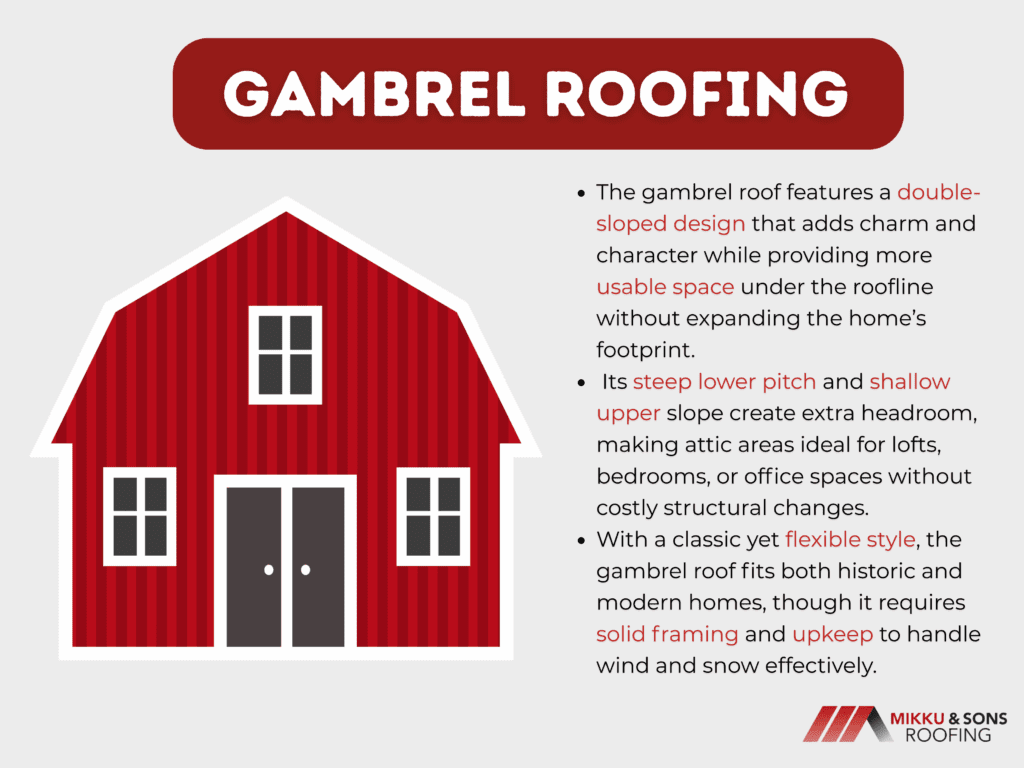
It’s easy to overlook the roof when you’re trying to make the most of your living space. Most people focus on square footage at ground level, but not above.
A gambrel roof adds extra room in a way that feels smart, not excessive. You aren’t forced to expand the foundation or add a full second floor just to squeeze in a little more living area.
The sharp lower slope combined with the gentler upper angle creates a larger and more usable upper floor. Instead of tapering off like traditional pitched roofs, this one stretches out the sides, giving you more vertical space.
That design can give you taller walls in your attic or loft area, which makes it easier to stand, walk, and furnish the space comfortably. This kind of structure works especially well when you’re trying to build in an attic bedroom, home office, or even a studio space.
It gives you more options without the construction costs of adding an entirely new level to your home.
With the added room a gambrel roof can give, you aren’t stuck with a narrow crawl space or awkward corners. The interior becomes flexible enough to shape around your needs.
It could become a full guest suite, a playroom, or just a spot where you finally have space to stretch out and focus. And because this roof opens up the interior so effectively, you might be able to skip that costly home addition you were considering.
You end up saving on materials, time, and labor while still gaining functional space that feels intentional. That kind of design choice can make a real difference when you're planning how to grow into your home instead of out of it.
Some roof styles come and go depending on trends or what the market is pushing. But a gambrel roof has a look that seems to fit no matter what year it is.
There’s a reason it’s stuck around for generations. It brings a certain charm to a home without feeling forced or overly styled.
The gambrel roof has strong roots in American architecture, especially in older colonial and Dutch-style homes. That influence still holds up today, adding a softer, more welcoming shape to a house, which makes it feel lived-in and personal.
While sharp modern angles or flat lines can feel cold to some, this design brings warmth just by the way it’s shaped. It can also break up the monotony of standard rooflines in neighborhoods where every house starts to look the same.
A home with a gambrel roof tends to catch the eye in a good way, offering a familiar shape that still feels a bit unexpected. It’s simple, but not boring.
With the right materials and finishes, the roof fits into newer builds just as well. Think wood accents, metal roofing, or clean trim lines that give it a more updated feel while keeping its original charm intact.
The versatility of this design also gives you room to play with your exterior style. It can support dormer windows, wrap-around porches, or even large picture windows without throwing off the balance of the roof.
When the weather turns rough, your roof becomes the first thing standing between you and the elements. You want something that not only holds up but actually helps your home deal with heavy rain, snow, and everything in between.
The lower portion of the gambrel roof comes in at a sharp angle, which helps move water and snow off faster. Water doesn’t have much time to sit and seep in, and snow doesn’t get the chance to pile up too heavily before gravity takes over.
That sloped design can reduce the chances of leaks, ice dams, and the kind of water damage that turns into bigger repairs down the line. Even in climates where winter hits hard, this kind of roof can handle the weight better than many flatter designs.
As long as it’s built properly and kept in good shape, the structure can stay strong under pressure without requiring constant cleanup or maintenance every time it snows.
When water drains off quickly and snow doesn’t have a chance to pile up, your roof doesn't have to work as hard to stay intact. That can mean fewer repairs over the years and less strain on the materials themselves.
You also avoid issues like rot or mold in the roof deck, which often show up when moisture has nowhere to go. Good drainage helps your whole house, not just the roof.
You’re less likely to deal with leaks around windows, water pooling near the foundation, or unexpected drips showing up inside. It’s one less thing you have to worry about every time the weather turns, and that peace of mind counts for a lot.
Budget always matters, no matter how big or small the project is. When you're looking at different roof styles, the cost can add up fast, especially once materials, labor, and time start stacking together.
A gambrel roof can offer a little relief, without cutting corners where it counts.
The shape of a gambrel roof makes the most out of a relatively simple frame. Because it uses fewer support beams compared to more complex roof styles, it often cuts down on the amount of lumber needed.
And since the slopes create more room inside the roof itself, you may not need to frame out a whole separate floor to get that usable space. This efficiency also means fewer materials for the outer layer.
The surface area is often smaller than it looks, due to the angles doing the work of adding volume.
Since the gambrel design follows a predictable structure, experienced builders can usually put it together faster than more complicated or custom roof styles. That speed can translate into fewer workdays, which means fewer hours on the clock and less spent on labor overall.
It also helps that many contractors are already familiar with this design. It doesn’t require specialty skills or niche materials, so you’re not stuck hiring someone at a premium just to get the job done right.
Every design choice comes with its own set of trade-offs. A gambrel roof can offer a lot, but it’s not always the perfect fit for every home or location.
Before you start sketching plans or talking to a contractor, it’s worth thinking through a few key details that could affect your build.
Gambrel roofs work best in certain regions more than others. In areas with high winds or frequent storms, the broad, tall shape can sometimes catch more air than a low-profile roof would.
This doesn’t mean it’s a bad option in storm-prone places, but it does mean you’ll want a solid framing plan and possibly some reinforced materials to keep things secure. Moist, coastal climates can also affect how long certain roofing materials last.
If you’re using wood shingles or other natural materials, they may need extra care in areas with a lot of rain or humidity. Local weather patterns can help guide which version of a gambrel roof works best for your home.
Not every neighborhood allows for bold roof designs, especially if you live in a place with strict homeowners’ association rules or tight building codes. Some areas have height restrictions, material guidelines, or requirements that your roof fits a certain “look.”
A gambrel roof can sometimes stretch those limits depending on how it’s built. Before you commit to the design, it’s smart to check with your local planning department or builder.
The last thing you want is to fall in love with a layout and find out it doesn’t meet zoning rules or neighborhood expectations. A little research upfront can save you the hassle of changing plans mid-build.
A gambrel roof can give you more space, a unique look, and practical benefits like better drainage and potential cost savings. But it also asks for thoughtful planning, especially when it comes to climate, structure, and maintenance.
Thinking about the bigger picture can also help you narrow down your options. Gambrel roofs fall under the category of sloped roofs, but they’re just one of many types out there.
It’s helpful to step back and consider how sloped roofs in general compare to flat ones. They each come with their own pros and trade-offs, and knowing how they stack up side by side can make your decision feel a lot more grounded.
Fixing a leaking tile roof can be a daunting task, but with the right approach, you can save your home from water damage and costly repairs. As a homeowner, it's essential to identify the source of the leak quickly and take action.
Whether it's a cracked tile, loose flashing, or worn-out underlayment, addressing the issue promptly is key. By following a step-by-step guide and using the right materials, you can restore your roof's integrity and ensure a dry, comfortable living space. With patience and some DIY skills, you can fix that leak and enjoy peace of mind.
Tile roofs are durable, but they aren’t indestructible. Over time, wear and tear, weather damage, and improper installation can lead to leaks. Ignoring small leaks can result in costly structural damage. That’s why identifying the cause early is crucial.
| Cause | Description | How It Leads to Leaks |
|---|---|---|
| Cracked or Broken Tiles | Weather, foot traffic, or impact can fracture tiles | Allows water to seep through to the underlayment |
| Damaged Underlayment | Aging or deteriorated waterproof layer beneath tiles | Loses effectiveness in repelling water |
| Faulty Flashing | Loose, rusted, or improperly sealed flashing around joints and openings | Water seeps in at vulnerable connection points |
| Poor Installation | Misaligned or poorly secured tiles | Creates gaps and weak points in the roof system |
Some of the most common signs of a leak include water stains on ceilings or walls, mold or mildew growth, dripping water during rainstorms, and musty odors in your attic.
If you notice any of these signs, address the problem immediately to prevent costly repairs. Whether it’s a minor fix or a major repair, understanding the source of the leak is the first step in protecting your home.
Detecting a leak early can save you from expensive repairs. Signs of a leak include water stains on ceilings, mold growth, or damp spots in the attic. You may also notice missing or shifted tiles on the roof. After a storm, inspecting the roof for visible damage can help catch leaks before they get worse.
By understanding the common causes and warning signs of a leaking tile roof, you can take the right steps to fix the issue before it leads to serious damage.
When faced with a leaking tile roof, you may wonder whether to fix it yourself or hire a professional. While some minor repairs can be done on your own, more serious issues require expert attention to ensure long-term protection for your home.
For homeowners who are comfortable working on their roofs, small repairs can be a DIY project.
Replacing a single cracked tile or sealing minor gaps with roofing sealant is manageable if you have the right tools and safety precautions. However, it’s important to assess the damage before attempting any repairs.
You may be able to handle simple fixes like replacing a broken tile, sealing small cracks with roofing sealant, or clearing debris from clogged flashing. These repairs can help prevent leaks from worsening if done correctly.
However, safety should always be your top priority. Working on a roof can be dangerous, especially on steep slopes or in wet conditions. Always use a stable ladder, wear slip-resistant shoes, and avoid walking on fragile tiles to prevent further damage.
While DIY repairs may seem cost-effective, hiring a professional is the best choice for major leaks, underlayment damage, or widespread tile issues. If water has already seeped into the underlayment or multiple tiles are broken, professional intervention is necessary.
Experienced roofers have the skills and equipment to inspect the roof thoroughly, repair deteriorated underlayment, and realign tiles properly. They can also ensure that repairs meet industry standards, preventing future leaks and costly damage.
If you notice water stains on your ceiling, mold growth, or a significant number of missing tiles, calling a professional is the safest and most reliable option. Investing in expert repairs can extend the lifespan of your roof and protect your home from further structural issues.
Repairing a leaking tile roof on your own can save money, but it requires the right approach to prevent further damage. Handling tiles incorrectly can cause more breakage, so taking your time and using the right techniques is essential. If the damage is minor and you feel comfortable working at heights, follow these steps to safely and effectively fix the leak.
| Step | Action |
|---|---|
| 1. Identify the Leak | Trace interior stains to roof, inspect for broken or displaced tiles |
| 2. Gather Materials | Ladder, harness, pry bar, replacement tiles, sealant, nails/clips |
| 3. Remove Damaged Tile | Carefully lift adjacent tiles, slide out broken tile |
| 4. Check Underlayment | Inspect for tears or damage; patch or replace as needed |
| 5. Install New Tile | Align and secure using appropriate fasteners or adhesive |
| 6. Seal Minor Cracks | Apply roofing sealant over small cracks as a temporary fix |
| 7. Monitor After Rainfall | Check for continued leakage to ensure repair was successful |
Before making any repairs, locate the exact spot where water is getting through. A visible crack in a tile or a displaced tile is usually a clear sign of trouble. If the leak is inside your home, trace the water stains on the ceiling to their highest point, then check the corresponding area on the roof. Keep in mind that water can travel along the underlayment before dripping inside, so the leak may not always be directly above the interior stain.
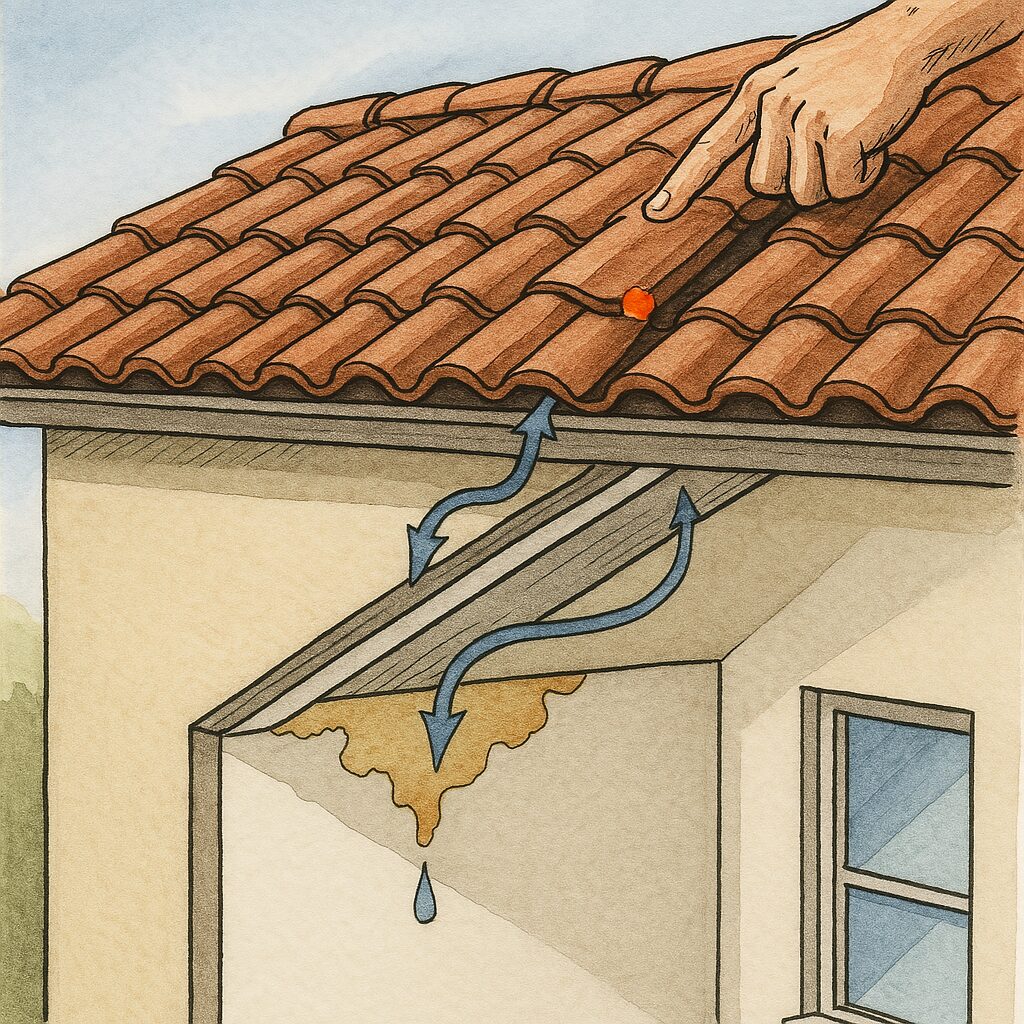
Once you’ve found the damaged area, you’ll need the right tools to complete the repair safely. A sturdy ladder, a roofing harness, and slip-resistant shoes are necessary for working on a tile roof. Avoid stepping directly on tiles, as they can easily crack under pressure. Instead, walk on the lower edges of tiles or use a plywood board to distribute your weight evenly.
You’ll also need replacement tiles that match your existing roof, a pry bar, a trowel, roofing sealant, and nails or clips to secure the new tiles.

To remove a cracked or broken tile, carefully lift the tiles above it using a pry bar. Most tiles overlap, so you’ll need to gently slide the damaged tile out without disturbing the surrounding ones. If the tile is stuck, avoid forcing it out, as this can break neighboring tiles. Instead, wiggle it free while applying gentle pressure.
Once removed, check the underlayment beneath the tile. If it’s torn or deteriorating, you may need to apply a waterproof patch or replace that section before installing the new tile.
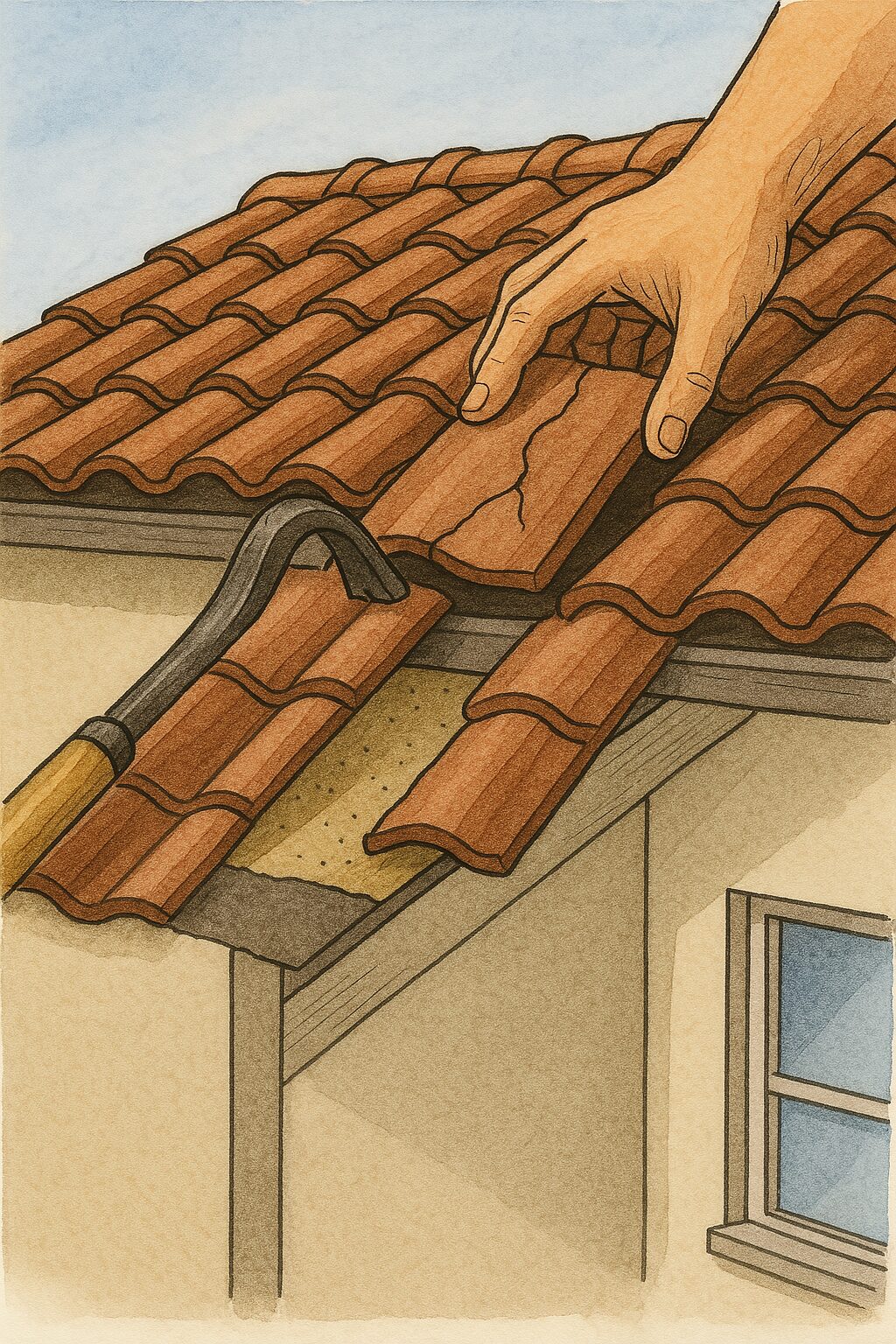
Slide the replacement tile into position, ensuring it aligns properly with the surrounding tiles. Depending on your roof type, tiles may be secured with nails, clips, or adhesive. If using nails, place them in pre-existing holes to avoid cracking the tile. If adhesive is needed, apply a small amount underneath the tile to hold it in place.
Make sure the new tile sits flush with the others and does not lift or shift. If it’s uneven, water can seep underneath and continue causing leaks.
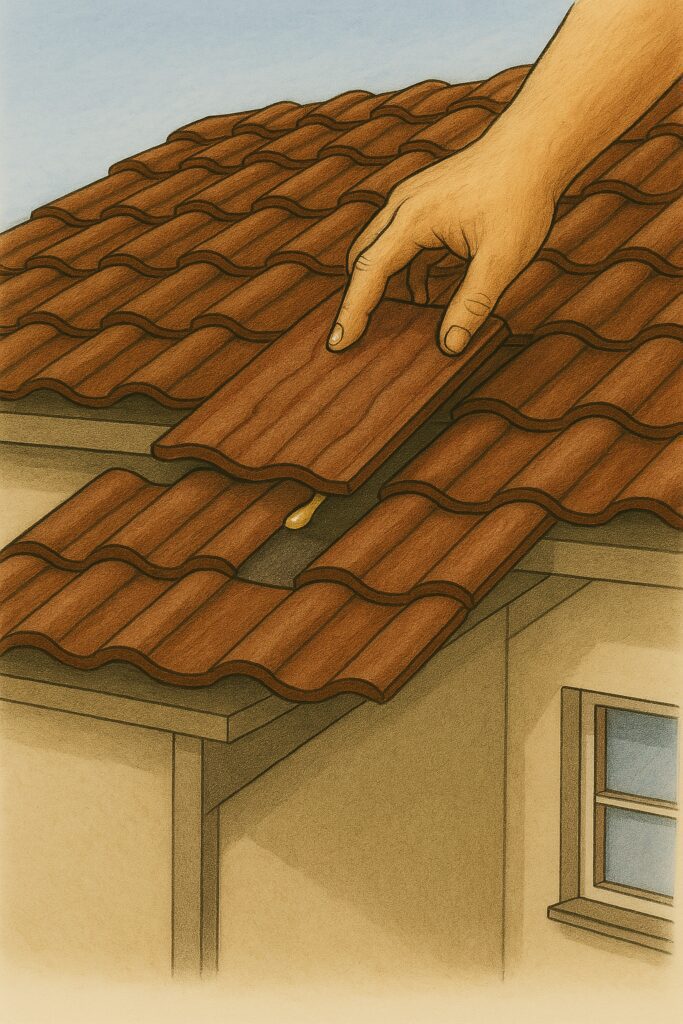
If your tiles are mostly intact but have small cracks, applying a roofing sealant can be a quick fix. Use a trowel to spread the sealant over the cracked area, ensuring it fills the gap completely. While this method won’t be as durable as replacing the tile, it can temporarily prevent leaks until a professional repair is possible.
After completing the repair, inspect the surrounding area for any additional damage. Check nearby tiles, flashing, and underlayment to ensure everything is in good condition. If you notice widespread damage, consider having a professional assess the roof for a more permanent solution.
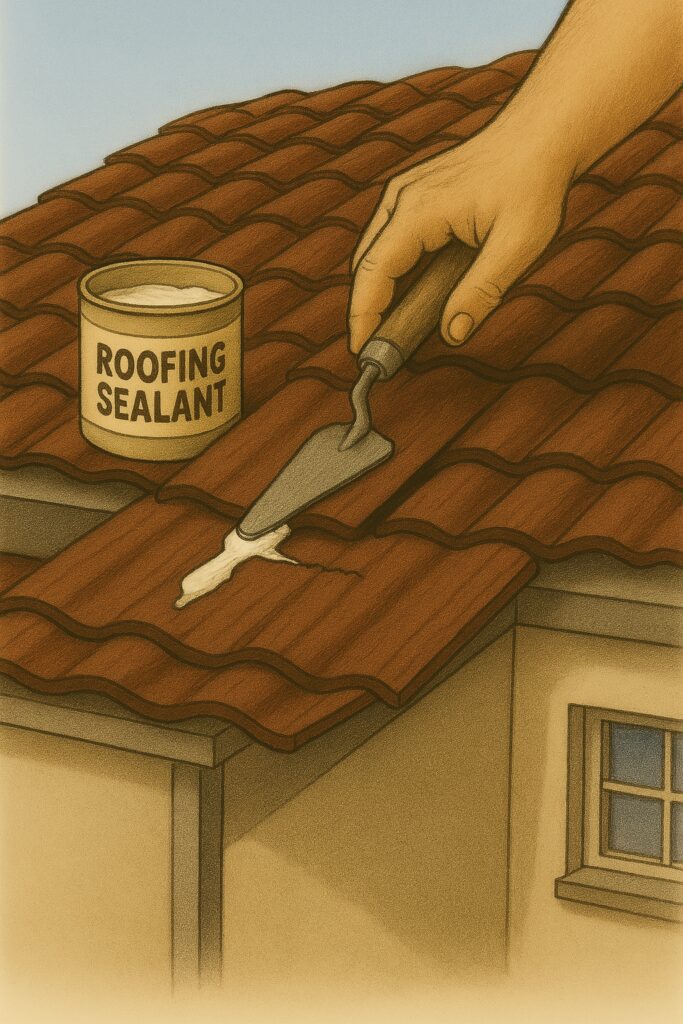
Once the repair is complete, keep an eye on the area after the next rainfall. If water stains or damp spots appear again, the problem may be more serious than a simple tile replacement. In that case, it’s best to consult a roofing expert to inspect for deeper issues, such as underlayment failure or structural damage.
By following these steps carefully, you can successfully repair minor leaks in your tile roof. However, if the damage is extensive or if you feel unsure about working at heights, hiring a professional is always the safest choice.
Tile roofs are known for their durability, but without proper maintenance, they can develop leaks over time. Regular upkeep helps prevent costly repairs and extends the life of your roof. By addressing small issues early, you can avoid major water damage and ensure your roof continues to protect your home.
| Issue | Prevention Strategy |
|---|---|
| Roof tile aging | Replace old or damaged tiles promptly |
| Poor drainage | Clean gutters and install guards |
| Flashing wear | Re-seal or replace as needed |
| Moss and debris accumulation | Use safe moss removers; trim trees nearby |
| Weak ventilation | Ensure attic is well-ventilated to prevent moisture buildup |
Inspecting your tile roof at least twice a year can help catch potential problems before they worsen. It’s best to check after heavy storms or extreme weather conditions, as strong winds and debris can damage tiles. Look for cracked, broken, or missing tiles, as even minor gaps can allow water to seep through. Pay attention to the roof valleys, as water tends to collect in these areas.
If you’re comfortable, perform a visual inspection from a ladder or the ground using binoculars. However, walking on a tile roof can be risky, as tiles can easily crack under pressure. If a closer inspection is needed, it’s safer to call a professional roofer.
Clogged gutters and drains can cause water to back up onto the roof, increasing the risk of leaks. Leaves, dirt, and debris can accumulate over time, blocking proper drainage. Regularly cleaning your gutters ensures that rainwater flows away from the roof instead of pooling around tiles.
Downspouts should also be checked for blockages. If water is spilling over the edges of your gutters, it’s a sign they need cleaning. Installing gutter guards can help reduce debris buildup and make maintenance easier.
Flashing is a critical component of your roof, sealing areas where water could enter, such as around chimneys, vents, and skylights. Over time, flashing can loosen, rust, or crack, creating weak points where leaks can develop. Inspect flashing regularly and reseal or replace it as needed to prevent water intrusion.
If you notice gaps or corrosion, applying a waterproof sealant can provide a temporary fix, but replacing damaged flashing is the best long-term solution. Flashing issues are a common cause of roof leaks, so keeping it in good condition is essential.
Branches that hang over your roof can cause serious damage. During storms, strong winds can snap branches, leading to broken tiles or punctures in the roof. Even smaller branches that constantly rub against the roof can wear down protective layers and weaken tiles.
Regularly trimming trees near your home reduces the risk of falling debris. It also minimizes the buildup of leaves and moss, which can trap moisture and lead to mold growth.
Moss and algae can take hold in damp areas of your roof, particularly in shaded spots. While they may seem like minor cosmetic issues, they can trap moisture and accelerate tile deterioration. Left unchecked, moss can lift tiles and allow water to seep underneath, leading to leaks.
To remove moss or algae, use a soft-bristled brush and a mild roof cleaner designed for tile surfaces. Avoid using pressure washers, as high-pressure water can crack or dislodge tiles. Preventative treatments, such as zinc or copper strips, can help keep moss and algae from returning.
A well-ventilated attic plays a crucial role in maintaining a healthy roof. Poor ventilation can trap heat and moisture, leading to condensation buildup that weakens the underlayment. Ensuring adequate airflow helps regulate temperature and prevents moisture-related damage.
Check your attic vents regularly to make sure they are not blocked by insulation or debris. If your attic feels excessively hot or humid, consider installing additional ventilation to improve air circulation.
As you've now mastered the art of fixing a leaking tile roof, it's time to explore other potential sources of water woes in your home. While roofs are often the first suspects when it comes to leaks, they're not the only culprits.
We'll now delve into the common causes of leaks that have nothing to do with your roof. From faulty plumbing to hidden issues in your walls, understanding these lesser-known sources can help you tackle water damage more effectively. Stay tuned for more insights on how to keep your home dry and secure.
Built-up roofing is one of the oldest and most trusted flat roofing options out there. You have probably seen it on commercial buildings, industrial warehouses, and even some residential properties.
It’s been around for over a century, and there’s a reason it’s still widely used today. Instead of relying on a single layer, BUR uses multiple layers of bitumen and fabric to create a strong and watertight surface.
This method makes it a solid choice for buildings that face harsh weather, heavy foot traffic, or the risk of fire. But is it right for you? There are several factors you need to consider before choosing it for your roof.
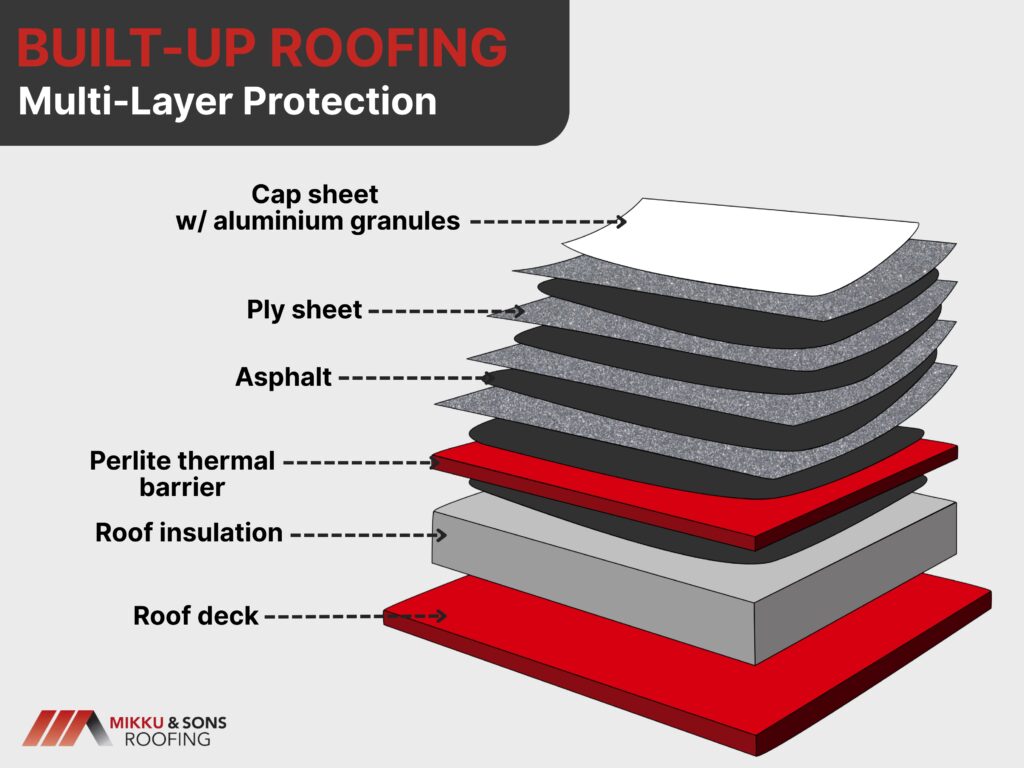
Built-up roofing (BUR) is created by layering multiple materials to form a thick, protective barrier over a building. This process involves alternating layers of bitumen (asphalt, coal tar, or cold-applied adhesive) and reinforcing fabric, such as fiberglass or organic mats.
These layers are then topped with a final protective surface, which can be gravel, mineral granules, or a reflective coating. The process typically follows these steps:
The number of layers in a BUR system can vary. Some roofs use three layers (a three-ply system), while others use four or more for increased durability and weather resistance.
There are different types of BUR systems, mainly categorized by the type of bitumen used and the finishing surface. Each type of BUR has its advantages and is chosen based on the building's needs, climate, and budget.
| Roof Type | Lifespan | Installation Complexity | Weight | Weather Resistance | Maintenance Needs | Cost Range (per sq. ft.) |
| Built-Up Roofing (BUR) | 20-30 years | High | Heavy | Excellent | Low to Medium | $5 - $10 |
| Single-Ply (TPO, EPDM, PVC) | 15-25 years | Medium | Light | Good | Medium | $4 - $8 |
| Modified Bitumen | 20-25 years | Medium | Medium | Very Good | Medium | $4 - $9 |
| Metal Roofing | 40-70 years | High | Heavy | Excellent | Low | $7 - $15 |
Some buildings benefit from the added fire protection of gravel, while others may prioritize energy efficiency with a smooth, reflective surface. Here are the most common variations:
A strong roof protects everything inside, stands up to the weather, and reduces the need for frequent repairs. Built-up roofing (BUR) has been a trusted option for decades because of the way it handles these challenges.
These strengths make BUR a smart option for buildings that need a roof that does more than just sit there.
A roof that wears down too fast can lead to costly replacements and constant repairs. BUR is designed to last longer than many other roofing systems because of its layered structure.
Each layer adds protection, preventing common roofing issues like leaks, cracks, and early deterioration. BUR can handle foot traffic and daily exposure to harsh elements without losing its strength.
Many BUR systems can last 20 to 30 years or more with proper installation and maintenance, making them a long-term solution for those who want fewer roofing headaches.
Roofs that fail under extreme weather can leave a building vulnerable to leaks, mold, and structural damage. BUR’s thick, multi-layered design provides excellent protection against heavy rain, strong winds, and intense sunlight.
Each layer works together to create a strong barrier that prevents water from seeping through and causing internal damage. Even in areas where temperature swings are common, BUR holds up well.
It can expand and contract without cracking, reducing the risk of sudden failures.
Fire safety is a major concern for any building, and some roofing materials can increase the risk of flames spreading. BUR is naturally fire-resistant, especially when topped with a layer of gravel or a reflective coating.
These materials help slow down the spread of fire, giving occupants more time to respond and emergency crews a better chance of controlling the situation. Some insurance providers even offer lower premiums for buildings with fire-resistant roofing.
This makes BUR a practical choice for businesses and homeowners looking to reduce fire risks while potentially lowering long-term costs.
A roof that constantly needs repairs can drain your budget fast. BUR installation costs can be higher upfront, but its long lifespan and low maintenance needs can make it a more affordable option over time.
The layered design helps prevent common roofing problems, reducing the need for frequent fixes. Because BUR can last for decades without major issues, property owners save money by avoiding early replacements.
When you factor in fewer repair costs and lower long-term maintenance expenses, BUR often proves to be a cost-effective investment.
Leaky roofs are one of the biggest concerns for any property owner, and seams are often the weak points where water finds its way in. BUR has fewer seams than many other roofing systems, reducing the chances of leaks developing over time.
The layered installation process creates a tight, secure surface that stays watertight even in harsh conditions. This seamless design also makes it easier to apply protective coatings or gravel to further enhance the roof’s strength.
With fewer weak spots, BUR provides reliable coverage that helps keep your building safe and dry for years to come.
Roofs are constructed with their strengths in mind, but none is perfect. Built-up roofing (BUR) offers solid protection, longevity, and fire resistance, but it also comes with drawbacks.
Before committing to BUR, it’s important to consider the downsides and see if they outweigh the benefits for your specific situation.
A strong roof is a good thing, but too much weight can be an issue. BUR is one of the heavier roofing systems available, and not all buildings can handle the extra load.
The multiple layers of bitumen and fabric, along with the gravel or reflective coating on top, add significant weight. In some cases, additional structural support is required to prevent stress on the building.
This can increase installation costs and extend the project timeline. If a building wasn’t originally designed to support a BUR system, reinforcing it can be expensive and may not always be practical.
Getting a BUR system installed isn’t as simple as laying down a few sheets of material. It requires a detailed, labor-intensive process that can take more time than other roofing options.
The use of hot asphalt or tar during installation can produce strong odors, making it unpleasant for people inside the building. For businesses, this can be disruptive, especially if the work is being done while operations are still running.
The longer installation time also means more labor costs, which can add up quickly. Compared to single-layer systems that go on quickly, BUR takes patience and skilled professionals to get it done right.
A flat roof isn't ideally flat and usually has a slope to it. BUR works well for low-slope roofs, but steeper roofs don't benefit from BUR's multi-layered design, and sometimes, the material may not adhere properly.
Buildings with weight restrictions or limited structural capacity may also struggle to support a BUR system without modifications. This makes it important to assess a building’s design before choosing BUR.
If the structure isn’t built to handle the extra weight or if the slope isn’t right, a different roofing system might be a better option.
Although BUR offers long-term savings, the initial investment can be high. The materials, labor, and time required to install it properly make it more expensive upfront than some other roofing systems.
| Cost Factor | Estimated Cost Range (per sq. ft.) |
| Materials (bitumen, fabric, gravel, coatings) | $2.50 - $5.00 |
| Labor (installation, skilled workers) | $3.00 - $7.00 |
| Structural Reinforcements (if needed) | $2.00 - $6.00 |
| Insulation (optional but recommended) | $1.50 - $3.50 |
| Maintenance (periodic inspections, minor repairs) | $0.10 - $0.50 (annual) |
| Repairs (leak fixes, patching layers) | $1.00 - $4.00 |
| Replacement (full re-roofing if necessary) | $6.00 - $12.00 |
This can be a dealbreaker for those looking for a budget-friendly option. The cost is often justified by the roof’s long lifespan and lower maintenance, but not everyone has the budget to cover the higher upfront expense.
If immediate affordability is a priority, BUR might not be the best choice.
Every roof has its maintenance needs, and fixing them can be a challenge when BUR develops issues. Since the system consists of multiple layers, pinpointing the exact location of a leak isn’t always straightforward.
Water can travel between layers before showing signs of damage, making it harder to detect the source of the problem. Patching a BUR roof also requires care.
If not done correctly, repairs can create weak spots or stand out visually from the rest of the roof. This can affect performance and appearance, which might be a concern for property owners who want a uniform look.
The type of roofing system you choose affects your building’s durability, maintenance needs, energy efficiency, and even long-term costs. Built-up roofing (BUR) has proven itself as a strong, long-lasting option, especially for flat and low-slope roofs.
The balance between form and function plays a key role in how a roof performs. Flat roofs require a roofing system that prevents water buildup and protects against UV exposure.
They provide more usable space and a modern, efficient design, but they also demand materials that can withstand standing water and heavy foot traffic. This is where the multi-layered construction of BUR excels as it creates a solid, watertight surface that works well in these conditions.
Missing shingles on your roof can leave your home vulnerable to water damage, energy inefficiency, and structural issues. Whether caused by severe weather, aging materials, or poor installation, addressing missing shingles promptly is crucial to preventing costly repairs. Understanding the causes of shingle loss can help homeowners take preventative measures and maintain their roof’s longevity.
This guide covers what to do if you have missing shingles on your roof, how to assess damage, make temporary fixes, and choose the best repair options. It also highlights the risks of ignoring missing shingles and key factors for replacement, helping you protect your home and extend your roof’s lifespan.
Missing shingles can be caused by various factors, ranging from weather conditions to aging materials. Understanding these causes can help homeowners take preventative measures to protect their roofs.
High winds, heavy rain, hail, and snow can loosen or tear shingles off the roof. Storms can also cause debris to strike the roof, leading to further damage.
Over time, shingles deteriorate due to exposure to sunlight, moisture, and fluctuating temperatures. As they age, they become brittle and more prone to cracking, curling, or falling off.
If shingles are not installed correctly, they may not be securely fastened and can detach more easily. Using improper materials or failing to follow manufacturer guidelines can also contribute to premature failure.
Birds, squirrels, and raccoons can damage shingles while searching for food or shelter. Their scratching, pecking, or nesting activities can loosen or remove shingles, leading to potential leaks.
Poor ventilation can cause heat and moisture buildup in the attic, leading to shingle deterioration from underneath. This weakens the adhesive and fasteners, making shingles more likely to come loose.

By understanding the common causes of missing shingles, homeowners can take proactive steps to maintain their roofs. Regular inspections and timely repairs can help prevent further damage and extend the roof’s lifespan.
Missing shingles on your roof can lead to leaks and further damage if not addressed quickly. Here’s what you should do:
Begin by visually inspecting the roof from the ground, noting the quantity and location of missing shingles. If it is safe to do so, use binoculars for a closer look. If you have a sturdy ladder and feel comfortable, you can carefully ascend to get a slightly better view but prioritize safety. Never walk on a wet or steep roof. Note any other signs of damage like curled, cracked, or loose shingles.
Use a heavy-duty tarp or reinforced plastic sheeting, not just thin plastic. Secure the covering with roofing nails or furring strips, ensuring it's taut and extends well beyond the damaged area. If windy conditions are expected, use extra fasteners and consider weighted objects to prevent the tarp from blowing away.
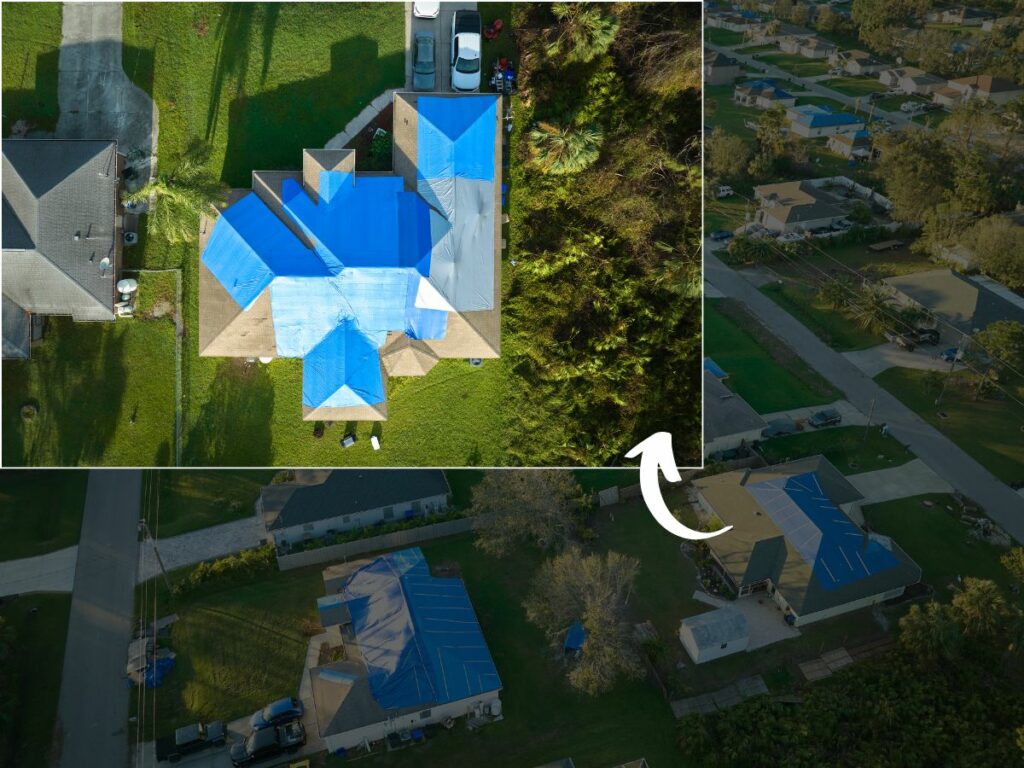
Obtain quotes from multiple reputable roofing contractors. Verify their licenses, insurance, and references. Ask about their experience with the specific type of shingles on your roof. A reputable roofer will provide a detailed estimate and explain the repair process.
Contact your insurance company immediately and document the damage with detailed photos and videos. Keep records of all communication with your insurer. If possible, get a copy of the police report if the damage was from a storm.
Remove any loose shingles or debris from the surrounding area and gutters. This will prevent further damage and make it easier for the roofer to work.
Maintain a detailed record of all expenses, including materials, labor, and insurance claims. This documentation will be helpful for insurance purposes and future repairs.
After the repairs are completed, conduct a thorough inspection of the roof, ideally with the roofer. Ensure that all shingles are properly installed and that there are no signs of leaks or other damage.
Addressing missing shingles promptly can help maintain your roof’s integrity and prevent costly repairs down the line. Whether you choose a DIY fix or hire a professional, taking action quickly is key.
Missing shingles may seem like a minor issue, but they can lead to serious consequences if left unaddressed. Understanding these risks can help homeowners take timely action to prevent costly damage.
Missing shingles expose the underlying roof structure to rain and moisture, which can lead to leaks. Over time, water infiltration can cause mold growth, wood rot, and interior ceiling damage.
A damaged roof can compromise your home’s insulation, allowing heat or cool air to escape. This can lead to higher energy bills as your HVAC system works harder to maintain a comfortable temperature.
Prolonged exposure to the elements can weaken the roof decking and support structures. If left unchecked, this can lead to costly repairs or even require a full roof replacement.
Gaps in the roof can provide entry points for rodents, insects, and birds. These pests can cause further damage by nesting in the attic and chewing on insulation or wiring.

A roof in poor condition can lower your home's curb appeal and resale value. Potential buyers may be deterred by the need for expensive repairs, making it harder to sell your home.
Addressing missing shingles promptly can prevent these serious consequences and help maintain the integrity of your home. Regular inspections and maintenance are key to avoiding long-term damage and costly repairs.
Replacing missing shingles is essential for maintaining the integrity of your roof and preventing further damage. However, several factors should be considered to ensure a successful and long-lasting repair.
It's important to choose replacement shingles that match the color, style, and material of the existing ones. Mismatched shingles can affect your home’s appearance and may impact its resale value.
Before replacing shingles, check for underlying issues such as water damage or weakened decking. If multiple shingles are missing or the damage is widespread, a partial or full roof replacement may be necessary.
Different types of shingles, such as asphalt, wood, or metal, offer varying durability and weather resistance. Consider your climate and budget when selecting materials to ensure longevity and protection.
While replacing a few shingles can be a DIY project, extensive repairs may require a roofing contractor. A professional can ensure proper installation and identify potential problems that might go unnoticed.
Plan shingle replacement during favorable weather conditions to avoid complications from rain, wind, or extreme temperatures. Spring and fall are often ideal times for roofing work due to mild temperatures.
Taking these factors into account can help ensure a smooth and effective shingle replacement. Proper installation and regular maintenance will keep your roof in top condition and protect your home for years to come.
Taking quick action when you notice missing shingles can prevent costly damage and keep your home well-protected. By understanding the causes, making temporary fixes, and considering the best repair options, you can maintain your roof’s durability and efficiency. Regular inspections and proper maintenance will also help you catch potential issues before they worsen.
Whether you choose to replace shingles yourself or hire a professional, ensuring a secure and weather-resistant roof is essential for your home’s longevity. By staying proactive, you can avoid major repairs, protect your investment, and keep your home safe from the elements.
Shingling a hip roof might seem like a job best left to the pros, but with the right prep and a step-by-step approach, you can tackle it yourself. Hip roofs, with their sloping sides meeting at a ridge, demand careful shingle installation to ensure a weathertight seal.
This guide will equip you with the knowledge to handle the task effectively. From prepping the roof and laying underlayment to cutting shingles for those tricky angles and finishing with ridge caps, each step is crucial. With attention to detail and safety, you can achieve a durable and attractive roof.
Installing shingles on a hip roof requires careful preparation and strict adherence to safety measures. Proper planning ensures a smoother installation process and helps prevent accidents. Before you start, it’s essential to gather the right materials, inspect the roof, and take necessary precautions.
Before beginning, make sure you have all the necessary tools and materials on hand.
Having the right equipment will save you time and prevent unnecessary delays. You’ll need roofing shingles, underlayment, roofing nails, a roofing hammer or nail gun, a chalk line, a utility knife, a tape measure, a pry bar, and a ladder. Additionally, ensure you have protective gear, including gloves, safety glasses, and a harness.
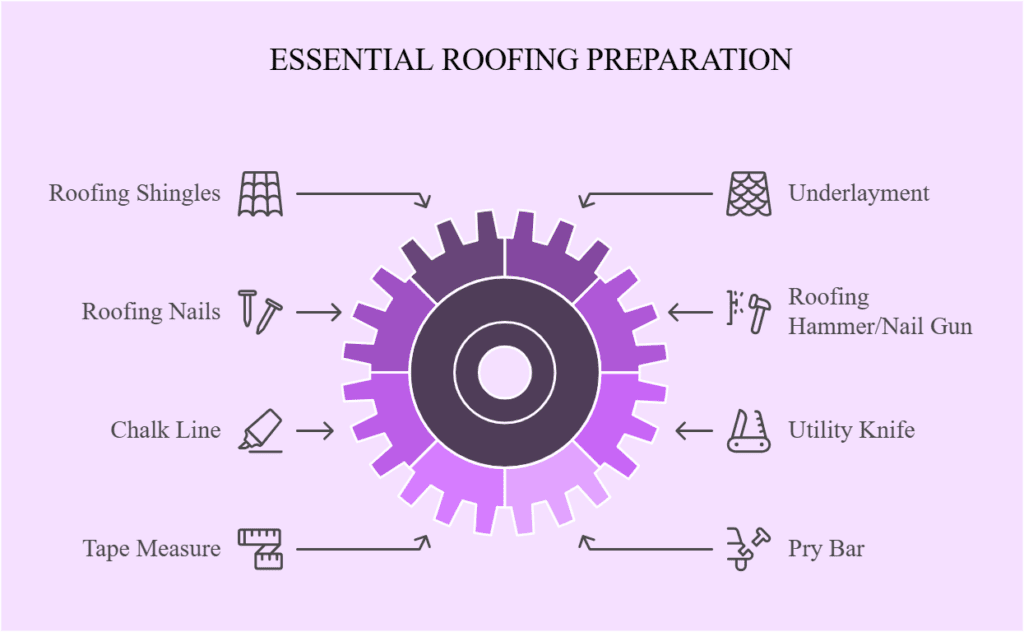
A thorough roof inspection is crucial before installing shingles. Look for signs of damage, such as rotting wood, water leaks, or structural weaknesses. If any issues are present, they must be repaired before shingling.
Installing shingles over a damaged roof can lead to costly repairs down the line. Replace any compromised plywood sheathing, reinforce weak areas, and ensure proper ventilation to prevent future issues.
The weather plays a significant role in the success of your roofing project. Ideal conditions for shingle installation include mild temperatures and dry weather.
Avoid installing shingles on rainy, windy, or excessively hot days, as these conditions can make the process dangerous and reduce the lifespan of your roof. Wet surfaces increase the risk of slipping, while extreme heat can soften the shingles, making them more prone to damage.

Roofing work comes with inherent risks, so safety should always be a top priority. Before climbing onto the roof, secure a sturdy ladder on a flat surface and wear a safety harness attached to an anchor point.
Never work on a roof alone—having a partner can help in case of an emergency. Additionally, wear non-slip shoes to improve stability, and always be mindful of your footing, especially on steep slopes.
Clear the work area of any debris, loose tools, or unnecessary materials that could create tripping hazards. If working on a residential property, inform those inside about the project to prevent accidental disturbances.
Keeping a clean and organized workspace reduces the risk of accidents and increases efficiency. Use caution tape or safety barriers to prevent unauthorized access to the area, especially if children or pets are nearby.
Once the roof deck is prepared, the next step is installing the underlayment. The underlayment acts as a moisture barrier, protecting the roof deck from water damage and leaks. Proper installation is key to ensuring long-term durability.
There are different types of roofing underlayment, and selecting the right one is essential for optimal performance. Asphalt-saturated felt is a traditional and affordable option that provides basic protection.
Synthetic underlayment is lightweight, durable, and resistant to tearing, making it a preferred choice for many professionals. Peel-and-stick underlayment is self-adhering and waterproof, ideal for areas prone to heavy rain and ice. Choosing the right underlayment depends on your climate, budget, and roofing needs. High-quality materials will provide better protection and longevity.
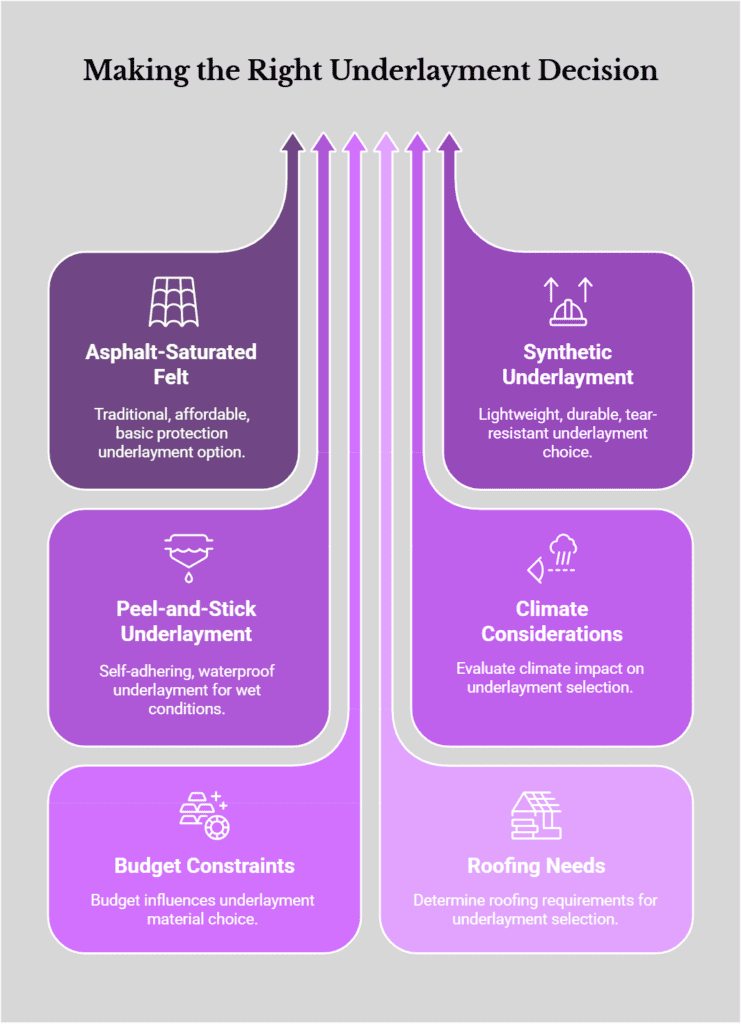
Correct installation of the underlayment ensures maximum effectiveness.
A properly installed underlayment enhances the overall strength of your roof and prevents water-related issues. Taking the time to do it right will save you from costly repairs in the future.
The drip edge and starter shingles are essential for protecting your roof from water damage and ensuring a strong foundation for the shingles. Skipping these steps can result in leaks, wind damage, and premature roof failure.
The drip edge is a metal flashing that prevents water from seeping into the fascia and roof deck. To install it correctly, start at the eaves and position the drip edge so it extends slightly beyond the roofline to direct water away from the structure.
Secure it with nails every 12 to 16 inches to prevent movement in high winds. Overlap sections by at least 2 inches to create a continuous barrier against water infiltration. Install the drip edge on the rakes after the underlayment for added protection against wind-driven rain.
Starter shingles provide the first layer of defense against wind uplift and water infiltration. Cut off the tabs of standard shingles or use pre-cut starter strips to create a flat surface for the first row.
Align the starter shingles along the roof’s edge with a slight overhang to direct water into the gutters. Secure them with nails near the adhesive strip, following the manufacturer’s guidelines for a firm hold. Ensure precise alignment, as any mistakes at this stage can impact the appearance and durability of the entire roof.
A well-installed drip edge and starter shingle layer reinforce your roof’s resistance to water damage and wind uplift. Taking the time to do it right ensures long-term durability and performance.
Once the starter shingles are in place, it’s time to lay the asphalt shingles. Proper installation ensures durability, weather resistance, and a professional finish.
Start by placing the first row of shingles directly on top of the starter shingles. Ensure they are properly aligned along the eaves and leave a small overhang. Secure each shingle with roofing nails, following the manufacturer’s guidelines for placement and spacing. Proper alignment of the first row is crucial, as it sets the foundation for the entire roof.
For a strong and visually appealing roof, stagger each row so that seams do not align. Cut shingles as needed to create an offset pattern, preventing water from seeping between seams. A staggered pattern improves water resistance and overall structural integrity.
Nail each shingle securely, placing nails below the adhesive strip. Use enough nails to keep them firmly in place, especially in high-wind areas. Press down on each shingle to ensure it adheres properly. Properly secured shingles prevent wind uplift and leaks.
As you install shingles, carefully cut and fit them around vents, chimneys, and valleys. Use flashing and roofing cement to seal these areas and prevent leaks. Attention to detail in these areas is essential for long-term durability.
Hips and ridges are critical areas of a hip roof that require special attention. Properly cutting and fitting shingles in these areas will enhance your roof’s durability and weather resistance.
Start by measuring the length of the hip to determine how many shingles you’ll need. Cut each shingle to fit along the hip line, ensuring a slight overhang for proper water runoff. Use a chalk line to maintain a straight and consistent alignment. This helps prevent uneven spacing and gaps that could lead to leaks.
Lay the shingles from the bottom of the hip, overlapping each piece as you go up. Secure each shingle with nails on both sides to keep them in place. Overlapping properly prevents water infiltration and strengthens the roof’s structure. Trim excess material to ensure a neat finish.
For the ridge, use specially designed ridge cap shingles or cut standard shingles into ridge caps. Position each piece evenly along the ridge and nail them in place, following the wind direction for extra security. Proper ridge installation helps with ventilation and extends the roof’s lifespan. Apply roofing adhesive for added hold in high-wind areas.
Taking the time to cut and fit shingles correctly on hips and ridges will improve your roof’s overall strength and appearance. A well-finished hip and ridge system ensures long-term protection against the elements.
Ridge cap shingles provide the final layer of protection for your roof’s ridges, preventing water infiltration and enhancing the roof’s appearance. Proper installation ensures durability and a clean, finished look.
Ridge cap shingles are specially designed to cover the peaks of your roof. You can use pre-cut ridge cap shingles or cut three-tab shingles into smaller sections. Using manufacturer-recommended ridge cap shingles offers better durability and a polished finish.
To install ridge cap shingles, start at the end of the ridge opposite the prevailing wind direction. Align the first ridge cap shingle and secure it with nails on both sides, placing them about an inch above the overlap area. Continue overlapping each shingle as you move along the ridge, ensuring a consistent and uniform look.Properly overlapping shingles prevent wind uplift and water penetration.
After nailing all the ridge cap shingles in place, apply roofing adhesive to the final shingle to ensure a firm hold. In high-wind areas, additional adhesive or nails may be required for extra security. A well-installed ridge cap protects your roof’s most vulnerable points and enhances its overall lifespan. Taking the time to do it correctly will keep your roof in top shape for years to come.
After installing the shingles and ridge caps, the last step is performing a thorough inspection and making any necessary final adjustments. Taking the time for a final check ensures a long-lasting and well-protected roof.
Go over the entire roof and inspect the shingles for proper alignment, ensuring they are evenly spaced and securely fastened. Look for any lifted or loose shingles that could lead to leaks or wind damage. A properly installed roof should have a clean, uniform appearance without visible gaps or misaligned shingles.
Check around vents, chimneys, and valleys to confirm that flashing is properly installed and sealed. Apply roofing sealant where necessary to reinforce areas prone to water infiltration. Proper sealing prevents leaks and extends the lifespan of your roof.
Remove any debris, stray nails, or leftover materials from the roof and surrounding area. Clear gutters of any shingle granules or obstructions to ensure proper drainage. Finally, conduct a final walkthrough to double-check that every component is correctly installed and secured. A thorough cleanup and inspection complete the roofing process, leaving you with a durable and reliable roof.
To install shingles on a hip roof, begin by securing flashing around ridges and edges. Then, start shingling from the bottom, overlapping each row by two-thirds of the shingle length. Ensure a staggered pattern and secure with nails.
Finish with ridge cap shingles for added protection. For more roofing insights, consider whether you can shingle over existing shingles, a topic explored in our previous blog post, which delves into the pros and cons of this approach.
Ever glance up and spot an unwelcome guest? Reddish brown spots on your ceiling? It's more than just an eyesore; it's your home's way of whispering, "Something's not right!" These spots can be mysterious, hinting at hidden plumbing leaks, roof vulnerabilities, or even sneaky mold lurking above.
Ignoring them is like ignoring a cough – it might get worse. So, let's unravel the mystery behind those spots. We'll explore common causes, from water damage to unexpected sources, and equip you with practical fixes to reclaim your ceiling and ensure a healthy home!
Reddish-brown spots on your ceiling are a sign of water damage, often caused by roof leaks, plumbing issues, or high humidity. Ignoring these stains can lead to mold growth, structural damage, and costly repairs. Identifying the cause early can prevent more serious problems.
Reddish-brown stains on your ceiling are a clear sign that something is wrong. These stains don’t just ruin the look of your home—they indicate potential water damage, leaks, or mold issues. Understanding the root cause is essential to fixing the problem before it gets worse.
Reddish-brown stains on your ceiling are more than just an eyesore—they signal an underlying issue that needs attention. Before you can fix the problem, you need to identify where the stains are coming from. Pinpointing the source early can prevent costly damage and potential health risks.
If the stain is located near the center of a room or along an exterior wall, a roof leak might be the cause. Damaged shingles, cracked flashing, or clogged gutters can allow water to seep into your home. Over time, this moisture collects in the ceiling, leading to discoloration and potential structural damage.
To check for a leak, look for missing, cracked, or curled shingles on your roof. Inspect your attic for wet insulation or water drips after rainfall. You should also examine the roof flashing around vents, chimneys, and skylights for gaps or damage that may be allowing water to seep through.
Ceiling stains beneath a bathroom or kitchen often point to a plumbing leak. A slow, hidden leak from a pipe or fixture can cause significant moisture buildup over time. Even small leaks can create persistent staining, weaken the ceiling material, and lead to mold growth.
To check for plumbing issues, look for water spots directly under sinks, toilets, or bathtubs. Check exposed pipes for condensation or drips. You can also run water in upstairs fixtures and monitor if new stains appear on the ceiling below.
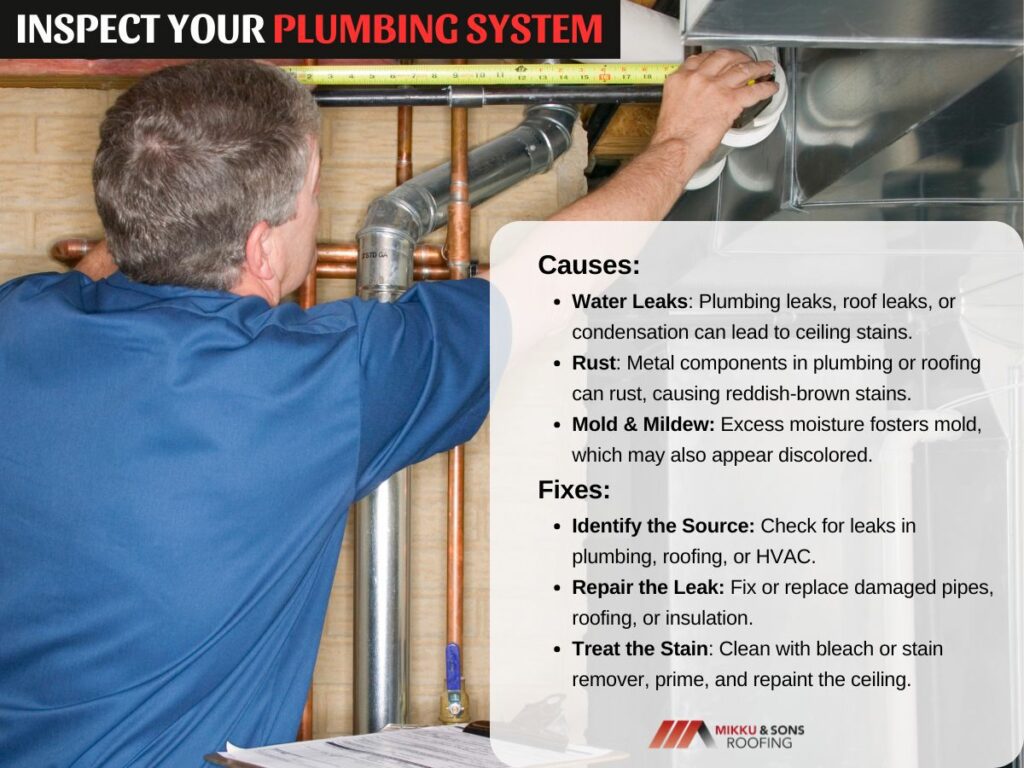
If the stain appears in areas with metal pipes, nails, or ductwork, rust could be the culprit. Rust forms when metal is exposed to moisture over time, causing brownish discoloration to seep through the ceiling. This is common in older homes with outdated plumbing or HVAC systems. If you suspect rust stains, inspect metal pipes and fasteners above the ceiling for signs of corrosion.
Poor ventilation can lead to condensation buildup, especially in humid rooms like bathrooms, kitchens, and attics. Excess moisture from everyday activities can collect on ceilings and walls, leading to stains. If a room has high humidity levels, condensation may be forming on cooler ceiling surfaces and causing discoloration.
To check for condensation problems, inspect areas with poor airflow for signs of mildew or peeling paint. Ensure exhaust fans are working properly in bathrooms and kitchens to remove excess moisture. If the problem persists, check attic ventilation to prevent moisture buildup.
If the stain has a musty smell or continues to grow, mold could be the issue. Mold thrives in damp environments and can cause brown, black, or reddish stains on ceilings. Mold exposure can also trigger allergies and respiratory issues, making it a serious concern for indoor air quality.
To identify mold problems, use a flashlight to inspect the stained area for fuzzy or speckled textures. Check for additional mold growth on walls, vents, or insulation. If mold is present, it’s important to address both the stain and the moisture problem causing it.
Reddish-brown stains on your ceiling aren’t just unsightly—they’re a sign of an underlying issue. Before you can remove the stains, you need to fix the root cause to prevent further damage.
Whether the stains are caused by a roof leak, plumbing issue, or condensation, here’s how to address them effectively.
Before cleaning or repainting, you must stop the issue that’s causing the stains. If you don’t fix the source, the stains will keep coming back.
If the problem is a roof leak, check for missing shingles, damaged flashing, or clogged gutters. Any roof damage should be repaired immediately to prevent further water infiltration. For plumbing leaks, inspect pipes above the ceiling for drips or moisture.
Tightening fittings or replacing damaged pipes can stop the issue before it worsens. If condensation is the problem, improve ventilation in humid areas like bathrooms and kitchens by using exhaust fans, dehumidifiers, or attic vents.
Once the source of the moisture is fixed, drying the ceiling thoroughly is the next crucial step. Trapped moisture can lead to mold growth and further ceiling damage. Use fans or a dehumidifier to remove excess moisture and speed up the drying process.
If the ceiling material is severely waterlogged, it may need to be cut out and replaced with fresh drywall. Ensuring the ceiling is completely dry before moving to the next step will prevent mold and mildew from forming.
After the ceiling is dry, you’ll need to remove the discoloration. The cleaning method depends on whether the stain is caused by rust, mold, or water damage. For water stains, mix equal parts bleach and water, then gently scrub the area with a sponge to lift the stain.
Rust stains can be treated with a vinegar or rust remover solution before wiping them clean. If mold or mildew is present, use a mold-killing cleaner or a mixture of bleach and water to eliminate spores and prevent regrowth.
Once the stain is cleaned, apply a high-quality stain-blocking primer to the affected area. This prevents the stain from bleeding through when you repaint.
Choose a primer specifically designed for water stains, as it will provide a better seal. Allow the primer to dry completely before moving on to painting.
After priming, repaint the ceiling with a color that matches the rest of the room. Using mold-resistant or moisture-resistant paint in high-humidity areas can help prevent future issues. Applying at least two coats will ensure even coverage and restore the ceiling’s appearance.
Reddish-brown stains on your ceiling are a warning sign of underlying issues like leaks, mold, or rust. Fixing the problem is only half the battle—taking preventative measures will help ensure the stains don’t return. Here’s how to protect your ceiling and keep your home in top shape.
Since roof leaks are a common cause of ceiling stains, regular roof maintenance is essential. Small cracks or missing shingles can allow water to seep in, leading to moisture buildup and discoloration. To prevent this, schedule roof inspections at least twice a year, especially after heavy storms.
Clear your gutters and downspouts to prevent water from pooling on the roof. Check for signs of damage like curled or missing shingles, cracked flashing, or sagging roof sections. If you notice any issues, repair them promptly to avoid leaks.
Plumbing leaks inside walls or ceilings can slowly create persistent stains. A small drip from a pipe or fixture can cause major damage over time. To prevent this, inspect pipes, faucets, and appliances regularly for leaks.
If your ceiling is beneath a bathroom or kitchen, check the plumbing connections for signs of wear. Look for damp spots, peeling paint, or unusual watermarks. If you suspect a hidden leak, hire a professional plumber to fix it before it worsens.
Excess moisture in your home can lead to condensation, which causes stains and mold growth. Proper ventilation helps control humidity levels and prevents moisture from settling on ceilings.
Make sure exhaust fans in bathrooms and kitchens are working efficiently. Open windows when cooking or showering to allow fresh air to circulate. If certain areas of your home remain damp, consider using a dehumidifier to reduce excess moisture.
If your home has metal pipes, nails, or HVAC ducts running through the ceiling, rust can be a problem. Moisture exposure over time can cause metal components to corrode, leading to brownish stains.
To prevent rust stains, ensure your home remains dry and well-ventilated. If you live in a humid climate, apply rust-resistant coatings on exposed metal surfaces. Replace old, corroded pipes or fittings before they cause further damage.
Mold thrives in damp conditions and can cause recurring stains. If you’ve had mold before, preventing its return is crucial for maintaining indoor air quality.
Keep your home dry by fixing leaks, improving ventilation, and using mold-resistant paint in humid areas. Clean and disinfect areas prone to moisture buildup, such as bathrooms, basements, and attics. If mold does appear, remove it immediately using a bleach solution or professional mold treatment.
Reddish-brown spots on ceilings often result from water intrusion, mold, or environmental factors. Common causes include roof leaks, faulty flashing, and leaking pipes.
To address these issues, inspect your roof for damaged shingles and ensure proper flashing. For plumbing leaks, check for worn-out pipes or clogs. After fixing the source, consider consulting our previous blog post on how to fix a leaking roof for comprehensive guidance on repairing roof-related problems.
When it comes to roofing, the spotlight often shines on the tiles themselves, but the unsung hero lurking beneath is the underlayment. This critical layer acts as a protective barrier, safeguarding your home from moisture, temperature fluctuations, and potential leaks.
Often overlooked, tile roof underlayment plays a vital role in enhancing the longevity and performance of your roof. By understanding its significance, homeowners can make informed decisions that not only protect their investment but also ensure peace of mind.

Tile roof underlayment is a protective layer installed beneath roof tiles to shield your home from moisture, leaks, and temperature fluctuations. Acting as a secondary barrier, it prevents water from seeping into your roofing structure when tiles are displaced or damaged.
Underlayment adds durability and protection, ensuring your roof remains effective for years. Without a reliable underlayment, your roof is vulnerable to leaks and structural damage. It also enhances energy efficiency by providing extra insulation.
Common options include felt, synthetic, and rubberized asphalt underlayments. Choosing the right type depends on your climate and roof design. Always consult a professional for the best choice.
Tile roofs are a popular choice for their durability, aesthetic appeal, and energy efficiency. However, beneath those beautiful tiles lies a critical component that ensures the roof performs its job effectively: the underlayment. Below are five key functions of tile roof underlayment:
1. Acts as a Secondary Barrier Against Water
The primary role of tile roof underlayment is to serve as a backup layer of waterproofing. While tiles are designed to repel water, wind-driven rain or improperly sealed tiles can allow moisture to seep through. The underlayment ensures that any water that gets past the tiles doesn’t reach the roof deck, preventing water damage, leaks, and mold growth.
2. Protects the Roof Deck from Damage
The roof deck, typically made of wood or composite materials, is highly vulnerable to moisture, heat, and other environmental factors. The underlayment acts as a protective shield between the tiles and the deck. By creating a barrier, it prevents the roof deck from deteriorating prematurely due to water, heat, or UV exposure, ultimately extending the lifespan of the roof.
3. Enhances Energy Efficiency
Modern underlayment materials are often designed to provide thermal insulation. This helps regulate the temperature inside the home by reflecting or reducing heat transfer through the roof. By minimizing heat absorption, the underlayment can improve energy efficiency, lower cooling costs, and create a more comfortable indoor environment.
4. Provides Additional Wind Resistance
In regions prone to high winds, tile roofs can experience uplift pressure that may cause tiles to dislodge or break. The underlayment helps secure the roof system by providing an added layer of stability.
It prevents wind-driven rain or debris from penetrating the roof and ensures the structure holds up during severe weather conditions. Some advanced underlayments are even designed to adhere more tightly to the roof deck for enhanced wind resistance.
5. Improves Tile Installation and Performance
Tile roof underlayment plays a crucial role during installation. It creates a smooth and even surface for laying the tiles, ensuring proper alignment and stability. The underlayment can absorb minor imperfections or unevenness in the roof deck, which improves the overall performance of the tile roof system. It also provides a safe walking surface for installers, reducing the risk of tile breakage during the process.
Roof underlayment may not be the first thing you think about when considering your roof, but its quality can make a world of difference. It acts as a hidden layer of protection that supports your roof's performance and longevity.
High-quality underlayment offers more than just a safety net—it provides practical benefits that impact your home’s durability, energy efficiency, and costs over time. Below, we break down the key advantages of investing in premium underlayment.
Increased Lifespan of the Roof
One of the most significant benefits of high-quality underlayment is its contribution to the lifespan of your roof. Roof tiles or shingles are the first line of defense against the elements, but they can become worn or damaged over time.
Underlayment acts as a second shield, preventing moisture, wind, and debris from compromising the integrity of your roof. By providing this extra layer of protection, high-quality underlayment helps reduce wear and tear on the visible components of your roof.
This means fewer repairs, less frequent replacements, and a roof that lasts longer overall. For homeowners looking to maximize their investment, quality underlayment is a must.
Enhanced Energy Efficiency
High-quality underlayment also plays a role in improving your home’s energy efficiency. Its insulating properties help regulate indoor temperatures by minimizing heat transfer through the roof. This is especially important in extreme climates where roofs are exposed to intense sunlight or freezing temperatures.
With better temperature regulation, your HVAC system doesn’t have to work as hard to maintain a comfortable environment. The result is lower energy consumption and reduced utility bills. If you’re aiming for a more energy-efficient home, upgrading your underlayment is a smart move that delivers long-term benefits.
Cost Savings
While high-quality underlayment may come with a higher upfront cost, it offers substantial savings in the long run. By preventing leaks, reducing energy expenses, and extending your roof’s lifespan, it lowers the overall cost of roof ownership.
For instance, roofs with inferior underlayment are more prone to damage, leading to frequent repairs and potentially costly replacements. Investing in a durable underlayment means fewer unexpected expenses and peace of mind knowing your roof is protected.
Selecting the proper underlayment for your tile roof is crucial to its performance and longevity. Underlayment acts as a critical barrier against moisture, wind, and temperature fluctuations, protecting your roof’s structural integrity.
| Underlayment Type | Pros | Cons |
|---|---|---|
| Asphalt-Saturated Felt | Affordable, traditional option, provides basic water resistance | Shorter lifespan, heavier, can wrinkle or absorb moisture |
| Synthetic Underlayment | Lightweight, durable, moisture-resistant, UV-resistant | More expensive than felt, requires professional installation |
| Rubberized Asphalt (Peel-and-Stick) | Superior waterproofing, strong adhesion, great for extreme weather | Higher cost, needs proper ventilation |
| Self-Adhering Membrane | Excellent for high moisture areas, easy installation, prevents ice damming | Costly, may not be needed in mild climates |
With various options available, making the right choice can feel overwhelming. This guide will help you understand the factors to consider and compare popular materials.
Choosing the right underlayment for your roof is a critical decision that impacts the durability, performance, and overall protection of your home. Here are key factors to consider when selecting underlayment:
1. Climate and Weather Conditions
The local climate plays a major role in determining the type of underlayment you need. In areas with heavy rainfall, hurricanes, or snowfall, water-resistant or waterproof underlayments like synthetic or self-adhered options are essential to protect against leaks and moisture damage. In hot climates, underlayments with UV resistance and heat tolerance are better suited to withstand extreme temperatures without degrading.
2. Roofing Material Compatibility
Different roofing materials require specific underlayment types to maximize their performance. For instance, tile roofs often need a thicker underlayment, such as asphalt-saturated felt or a synthetic underlayment, to handle the weight and provide added moisture protection. Metal roofs, on the other hand, benefit from underlayments designed to prevent condensation. Ensure the underlayment you choose is compatible with the roofing material for optimal results.
3. Durability and Lifespan
Not all underlayments offer the same longevity. Some options, like synthetic underlayments, are designed to last longer and resist wear and tear compared to traditional felt. If you’re investing in a long-lasting roof material like tiles or metal, it’s crucial to select an underlayment that matches its lifespan to avoid premature replacement. Look for tear resistance, UV stability, and waterproof properties as indicators of durability.
4. Installation Requirements
Some underlayments are easier to install than others, which can influence labor costs and overall project timelines. For instance, self-adhering underlayments simplify the installation process by eliminating the need for nails, while felt underlayments may require more labor-intensive methods. If you’re working with a professional roofing contractor, ask about installation preferences and the impact on total costs.
5. Cost and Budget
Underlayment costs can vary widely based on material type, brand, and quality. While traditional felt is more affordable, synthetic underlayments tend to offer better performance and longer lifespans, making them a more cost-effective choice in the long term.
| Underlayment Type | Cost Per Square Foot | Estimated Lifespan |
|---|---|---|
| Asphalt-Saturated Felt | $0.50 – $1.00 | 10 – 20 years |
| Synthetic Underlayment | $0.75 – $1.50 | 25 – 50 years |
| Rubberized Asphalt | $1.50 – $3.00 | 30 – 50 years |
| Self-Adhering Membrane | $1.75 – $3.50 | 30 – 50 years |
When selecting an underlayment, balance your budget with the desired level of protection and durability to ensure a smart investment.
Tile roof underlayment plays a crucial role in protecting your home from moisture and ensuring the longevity of your roof. Its importance cannot be overstated, as it serves as a barrier against leaks and enhances overall energy efficiency.
As we shift our focus to the next topic, we'll explore the best tile roof underlayment options specifically suited for Arizona's unique climate. Understanding the available materials and their benefits will empower you to make an informed choice that enhances your roof's performance and durability.
Your roof goes through countless rainstorms in its lifetime, and you wouldn't want one of these to invite a leak into your house. A roof leak is far from rare and it might be a sign that your underlayment is failing.
While tiles themselves often last long, the underlayment does not last as long. If you've noticed any signs of aging on your roof, or if it's been a while since the last inspection, it could be time for a check-up.
Ignoring these signs can lead to more severe damage, not just to your roof but also to the interior of your home. Replacing tile roof underlayment ensures that there are no leaks and that the lifespan of the tile roof is ensured.
Before going up a ladder and stripping away the old tiles, you need to know what makes up the roof. The underlayment is not a visible layer, but it is important to make your roof whole.
It is your roof's first line of defense against water intrusion and weather damage. The right underlayment can extend the life of your roof tiles by blocking moisture that might otherwise weaken them over time.
It is essentially a barrier material installed directly onto your roof deck under all other roofing materials as an added layer of protection from severe weather. Without it, even minor leaks can lead to major issues.
There are a number of underlayment to choose from when building your roof. Each have unique benefits for different roofing conditions and climates.
Felt underlayment, often referred to as tar paper, is the traditional choice that has been used in roofing for decades. It’s made from either organic or fiberglass substrate coated in asphalt. Felt comes in two main types:
This is made from recycled paper and wood fibers saturated with asphalt. It’s heavier and more water-resistant than many other underlayments but less durable when exposed to UV rays or high temperatures.
This type combines fiberglass with asphalt, offering improved resistance to tearing and better stability in high temperatures. Felt underlayment is usually less expensive than synthetic alternatives and works adequately for many standard roofing projects.
However, it can absorb water, become brittle, and break down faster if exposed to prolonged moisture or high temperatures.
Synthetic underlayment is a more modern solution made from woven or spun polyethylene or polypropylene. It is engineered to offer several advantages over traditional felt, including:
Synthetics are much stronger than felt and can withstand high winds and foot traffic during installation. They are lighter per square foot, which makes them easier and faster to install.
The materials also don't absorb water, which helps prevent mold growth and decking rot. Some synthetic underlayments are resistant to UV degradation, allowing them to be exposed for weeks or even months during prolonged construction projects.
Rubberized asphalt underlayment provides the highest level of waterproofing and protection. It contains rubber polymers and asphalt that create a waterproof barrier.
The rubberized nature of the material allows it to seal around nails that penetrate through, which greatly reduces the risk of leaks. This type of underlayment typically features a peel-and-stick application that bonds securely to the roof deck, providing excellent wind resistance.
This underlayment is ideal for regions prone to ice damming or where water accumulation is a concern, such as valleys and roof protrusions. Due to its superior waterproofing qualities, rubberized asphalt is often used in critical areas rather than over the entire roof.
It's not always obvious, but there are key indicators that can signal when your roof needs some attention. This is also the case for the non-visible layers like the underlayment.
If you know how to check for the damage you can have an idea whether you need a replacement or not.
One of the most straightforward signs that your underlayment may need replacing is the presence of water damage or leaks inside your home. If you notice water stains on your ceilings or walls, it's a clear indicator that water is breaching your roof’s defenses.
While tiles might be the first line of defense, the underlayment is what really keeps the water out. When it fails, moisture finds its way in, which can lead to costly interior damage.
While inspecting the tiles themselves might seem more related to the tiles than the underlayment, these signs can also indicate underlying issues. Cracked or missing tiles can expose the underlayment to direct sunlight and weather elements, accelerating its degradation.
If you start noticing an unusual amount of tile damage, it could be a sign that the underlayment is no longer providing the support and protection it should.
A sagging appearance in the roof is a red flag that should not be ignored. This can be a sign that the decking, supported by the underlayment, has been exposed to moisture for an extended period.
The constant presence of moisture can weaken the decking material, leading to a sagging or warping appearance. This structural compromise not only puts your roof at risk but can also affect the overall integrity of your home.
If you find yourself repeatedly addressing roof repairs, especially after every bout of severe weather, it might be a sign that your underlayment is failing. A well-functioning underlayment should offer a certain level of robustness against routine weather challenges.
Frequent repairs can indicate that the underlayment is no longer performing effectively, allowing more frequent and extensive damage to the roof tiles and structure.
Replacing the underlayment on your roof is a significant undertaking that requires careful planning and preparation. The right preparation can make the difference between a job well done and one that might need revisiting sooner than expected.
Timing is everything when it comes to roof work. Ideally, you want to schedule the replacement during a period of mild weather.
Extreme conditions—whether hot or cold—can complicate the installation of underlayment and roofing materials. Most professionals recommend undertaking roofing projects during the spring or fall when the weather is generally more predictable and temperate.
The choice of underlayment material is critical and should be influenced by the climate in which you live. Different materials perform better in different environments.
For instance, synthetic underlayments are often preferred in wet climates due to their superior moisture resistance, while felt might be adequate in drier regions. Consider also the longevity and durability of the materials.
Before you start, remember that roof work can be dangerous. Prioritize safety by using proper equipment and, if necessary, consider hiring professionals.
If you choose to proceed on your own, here’s how to replace the underlayment beneath your tile roof.
Safety cannot be overstated when it comes to working on a roof. Ensure you have a sturdy ladder, non-slip footwear, gloves, and safety goggles. Consider using a safety harness if the roof is particularly steep or high.
Clear the area around your home of any objects or debris to keep the work zone safe and unobstructed.
Start by carefully removing the tiles. Begin at the ridge or peak of the roof and work your way downwards.
Use a flat pry bar to lift the tiles gently, being careful not to crack or break them. It’s wise to have extra tiles on hand in case some do break.
Stack the removed tiles neatly away from the work area. Ensure they are on stable ground to prevent any accidents or additional breakage.
Once the tiles are removed, inspect the roof deck. Look for any signs of damage such as rot or structural weakness.
This is crucial as installing new underlayment over a compromised deck can lead to future problems. Next, remove the old underlayment, it may be nailed or stapled down.
Use a roofing shovel or scraper to remove it, being careful not to damage the roof deck.
Start from the bottom of the roof and work your way up. Roll out the new underlayment horizontally across the roof, overlapping each layer by at least 6 inches.
This overlap is critical for preventing water infiltration. Secure the underlayment with roofing nails or staples.
Make sure it lies flat and smooth against the roof deck.
Begin replacing the tiles from the bottom of the roof. Make sure each tile aligns correctly with those next to it. Misalignment can lead to gaps and potential leaks.
Use new fasteners to secure the tiles. Avoid reusing old nails or staples as they may not hold as securely after being removed.
While many home improvement tasks are manageable on your own, replacing roof underlayment might be a project where enlisting professional help is prudent. A well-chosen expert can ensure that the job is done efficiently and correctly, protecting your home for many years to come.
Understanding the scope and risks associated with replacing underlayment can help you decide whether to tackle the job yourself or hire a professional. Consider the following:
Evaluate your skills and experience. If you have experience with roofing projects and feel comfortable working at heights, you might handle some or all of the task yourself. However, if you're unsure about any part of the process, professional help is advisable.
Assess the project’s complexity. If your roof has multiple levels, steep slopes, or requires extensive repairs, these complexities are often best handled by a professional.
Choosing the right contractor is crucial for ensuring your roof’s longevity. Here are essential factors to consider:
Once you’ve selected a contractor, there are a few steps you can take to prepare for their arrival and the start of the project:
Your roof has many components that have specific needs and maintenance requirements. With new underlayment securely in place, your roof's durability against weather and wear greatly improves even during those stormy months.
If you're considering clay roof tiles, the choice of underlayment becomes even more impportant. Clay tiles are known for their longevity and ability to enhance the thermal efficiency of your home.
However, their performance hinges on the support that only a strong, properly installed underlayment can provide. With an underlayment in good condition, you maximize the protective benefits of clay tiles.